Your TESOL Learning Journey
Congratulations! You’re now certified to teach English as a Second Language (ESL) classes! You’ve laughed at your trainer’s jokes, including those that weren’t funny, completed the coursework and landed a terrific job. You’re supremely confident, and students are lining up to learn English from ‘the messiah’.
“You’re dreaming”, I hear you say. Okay, you haven’t jumped through all the hoops yet, but you’re on the right path. While this alone is good news, here’s some even better news. The Australian Government-accredited TESOL course at AVSE-TESOL (11245NAT) will equip you with the knowledge, skills and valid certification needed to hit the ground running as an ESL teacher anywhere in the world. The assumption is you’re currently at ‘zero’, and the challenge is to be at ‘hero’ by the end of the course. Enjoy the ride.

TESOL overview
English is used worldwide in business, education, social settings, and networking. While French might be the language of love, English is commonly known as the international language. As a result, teaching ESL has become an industry in its own right, attracting all kinds of people – high-flyers, plodders, difference-makers, backpackers looking to fund their travels, educational purists, and academics.
Regardless of background or country of origin, fantastic opportunities await people with decent English language skills and quality TESOL certification, regulated and accredited by a government. Teachers hold an esteemed position in Southeast Asian countries like Vietnam and Cambodia. This esteemed position is reason enough not to scrimp on acquiring the skills, knowledge, and certification you need to work as an ESL teacher in that part of the world.
The Australian Government-accredited Certificate IV in TESOL, the Trinity Certificate in TESOL, and CELTA are three examples of high-quality study programmes for aspiring ESL teachers. What’s the commonality between the Australian Certificate IV in TESOL, Trinity TESOL and CELTA? Each is regulated and accredited by a government. It’s about quality, accountability and tangible outcomes for teachers and students.
You will find information about AVSE-TESOL’s Registered Training Organisation (RTO 45373) status in Australia here. Also, please view the details of our Australian Government-accredited Certificate IV in TESOL programme here.
Things you will learn
This course is the foundation upon which you’ll build a rewarding career as an ESL teacher. It covers essential knowledge and skills that every English language teacher must have. Check out five crucial things you will learn during your TESOL course, in the short video immediately below.
The Certificate IV in TESOL qualification (11245NAT) under the Australian Qualifications Framework comprises the 12 Units of Competency noted below.
- NAT11245001: Plan and prepare English lessons
- NAT11245002: Assist learners in improving pronunciation and speech
- NAT11245003: Assist learners in building English grammar skills
- NAT11245004: Source and develop resources to support learning
- NAT11245005: Assist learners develop reading and writing skills
- NAT11245006: Assist learners in developing speaking and listening skills
- NAT11245007: Assess language learning
- NAT11245008: Apply a range of TESOL methodologies
- NAT11245009: Assist learners in preparing for English language tests
- NAT11245010: Use Computer Assisted Language Learning to assist learners
- NAT11245011: Develop and apply knowledge of cultural factors affecting TESOL teachers
- NAT11245012: Use creative strategies to assist children in learning English
Assessment tasks
Assessment tasks will receive one of two grades: ‘Competent’ or ‘Not Yet Competent’. TESOL students must achieve a ‘Competent’ grade with all assessment tasks to be awarded a Certificate IV in TESOL (11245NAT) under the Australian Qualifications Framework (AQF). Suppose an assessment task that you’ve submitted is deemed ‘Not Yet Competent’. In that case, you can revise your work and resubmit it without penalty (within reason). Here are three ‘hacks’ that will help avoid being asked to repeat an assessment task: 1. carefully read and follow the instructions for each task, 2. don’t cut corners, and 3. conduct a ‘self-audit’ process before you hit the submit tab.

Assessment submission
Your enrolment duration is six months. You may submit your assessments until 11:59 pm on the last day of your enrolment.
You must submit assessment tasks via the appropriate link on the AVSE-TESOL Student Portal. If a file is too large to submit via the Student Portal, you should compress it and try again. If you cannot submit a file, despite your best efforts, contact your personal TESOL trainer as a first option. AVSE-TESOL cannot accept assessment tasks submitted via email, Facebook Messenger, or similar means. You will encounter several assessment tasks in the Student Portal in a ‘Quiz’ format. Completed quizzes are stored in the Student Portal without the need for any uploading.
Various file uploads such as tests, resources you have gathered, lesson plans you have created, observations undertaken and evaluations of teaching performance during practicums are part of your course assessment requirements.
What do you get for successfully completing the course?
While we don’t hand out gold stars (or gold bars) at the end of the TESOL programme, all being well, you will receive the following Australian Government accredited qualification: Certificate IV in TESOL (Teaching English to Speakers of Other Languages, 11245NAT).
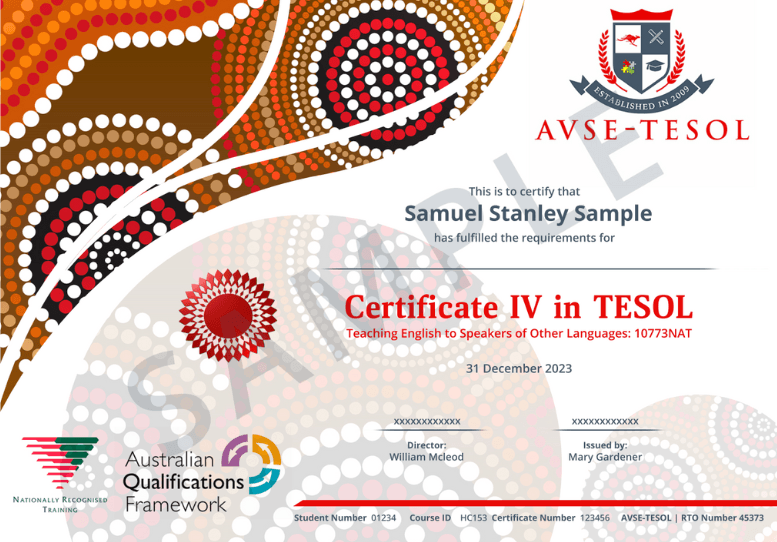
Typically, it takes ten business days (Monday to Friday) from the date you meet the course requirements to receive your TESOL certificate. The content and design of the certificate are consistent with the AQF’s ‘Qualifications Issuance Policy’. You will receive your TESOL certificate in ‘hard copy’ format.
Students can collect their TESOL certificate at the location where they completed the training. Alternatively, AVSE-TESOL can arrange for the certificate to be posted by secure mail for a fee set by the local postal service. AVSE’s advertised programme fee does not include a postage charge.
Here are a few words from Peter Goudge, our Managing Director and Founder
As a young person, I discovered the lifestyle and benefits of teaching English abroad. More than anything, I’m grateful for what this profession has given me – and my family. I’ve worked in the four corners of the world and met more magnificent people than I can name. What’s my advice to newcomers in this profession? Simple: 1. learn to work with local people, and 2. always remember you’re a visitor.
Computer Assisted Language Learning
Perspective:
Undoubtedly, Computer-Assisted Language Learning (CALL) is an essential component of teaching and learning English as a Second Language (ESL). Nowadays, technology is used in classrooms worldwide. CALL brings together education and innovation, providing opportunities for teachers and learners everywhere. At its core, CALL can involve basic tools for vocabulary practice. However, it can also include advanced learning platforms that tailor instruction to meet the personal needs of individual students.
CALL has become essential to teaching and learning ESL because of its wide range of applications. Unlikely as it sounds, there are still teachers who believe they can deliver quality ESL lessons without including CALL. They’re wrong. They’re ‘dinosaurs’. ESL students expect their teachers to have at least basic information technology skills. That expectation is not unreasonable in my view; employers (schools) agree.
Immediately below you’ll see a video from Ms Laura Patsko (Senior ELT Research Manager, Cambridge University Press), sharing findings from a major research project about the effectivesness of CALL in ESL teaching and learning. While the video is a few years old, the findings are equally relevant today. I’m sure you’ll find it interesting.
The role that information technology plays in ESL classrooms around the globe will only expand as new technologies emerge, transforming how students engage with language learning. Suppose your information technology skills are a ‘work in progress’. In that case, I’d encourage you to ‘put your foot on the gas’ so CALL becomes an integral part of the ESL lessons you deliver in the future.
Acquiring basic skills to use technology in the classroom may be a hurdle you must overcome, but it doesn’t stop there. What about ‘troubleshooting’? With technology comes the prospect of technological failure and mishaps. How will you respond when the projector globe blows, the PC crashes, the CD is scratched, the speakers won’t work, someone changed the Wi-fi password and didn’t let you know, you brought the wrong computer cable to class, or the power goes out leaving you in a dark room with no air conditioning and forty or more students. ‘Worst nightmare’ scenarios do happen, especially in developing countries like Vietnam and Cambodia. So, what’s your Plan B (and Plan C) in the event of technological failure or a mishap?
An array of tools:
CALL can be teacher-led, student-led, school-led, independent, classroom-based, home-based and so on. It can be utilised anywhere, provided a suitable device and internet access exists. Here are some examples of CALL-related technology: computer software, games, simulations, language tutorials, translators, internet, email, blogs, Skype, Zoom, WhatsApp, Viber, Facebook, podcasts, mp3s, YouTube, mp4s, videos, DVDs, CDs – the list is endless. The common characteristic is that an electronic device – a computer connected to the internet – drives an application that allows teaching and learning.
If your curious how to use information technology in your classroom, check out the video below from Sam Kary, CEO and Founder of New EdTeach Classroom:
Early classroom technology was simple, like watching a wildlife documentary on your school’s telly. In the 1980s, some schools introduced ‘Language Laboratories,’ where students would record themselves speaking on bulky tape recorders and listen back to improve their pronunciation. It’s hard to imagine now, but the tape recorder was considered cutting-edge technology.
These days, in classrooms around the world, you won’t find a bulky, old tape recorder, but you will find mobile apps, advanced online platforms and gamification galore directed at making the hard yards of learning new things engaging and fun. The engagement and fun components of CALL are hard to dispute. In addition, it’s hard to argue to the contrary that CALL provides adaptable, engaging, and easily accessible resources, which enhance the appeal of teaching and learning English compared to traditional methods.
Popular apps:
When a student uses an ESL app during a lesson, you could be excused for thinking the atmosphere is more akin to what you’d expect at a competitive football or basketball match than in a traditional classroom. Why? Many apps come with a hefty gamification component to capture and hold interest.
While it’s physically impossible to list every ESL teaching and learning app that’s available in the marketplace, here’s a random selection of apps that are commonly used in Southeast Asia: Duolingo, Babbel, ELSA Speak, Space-team ESL, Memrise, Hello Talk, Voxy, Busuu, English Grammar Star, Lingoda, Fluentless, My Wordbook, Cram and Cambly. Online dictionaries and translation tools – for example, Google Translate and WordReference – are standard features in ESL classrooms worldwide, providing instant access to definitions, pronunciation assistance, sample sentences and much more.
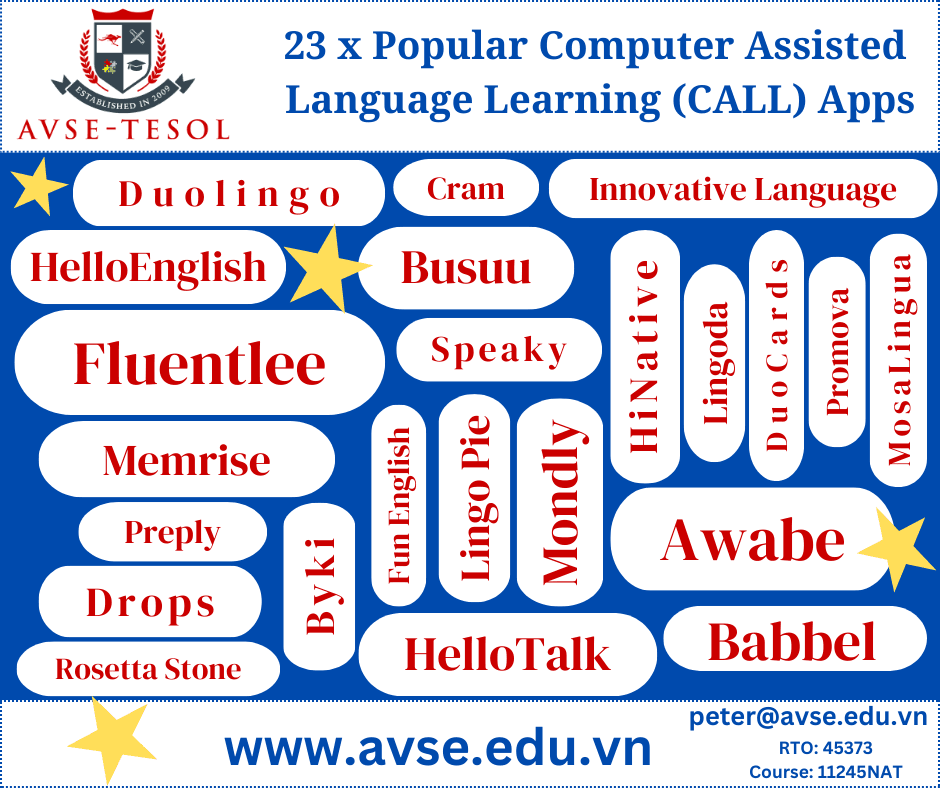
What’s in it for teachers?
Just as CALL offers benefits for ESL students, there are benefits for teachers also. Immediately below, you’ll find a list of eight benefits that CALL provides for ESL teachers:
– Enhanced Engagement: ESL students love information technology – watch their eyes light up when you introduce an app to the teaching and learning experience. Engaged students are far more likely to achieve desirable outcomes and less likely to be at the centre of undesirable class management issues.
– Personalised Learning: Many CALL programs can be adapted to meet individual student’s needs. With CALL, teachers can effectively provide one-on-one attention to multiple students simultaneously.
– Access to Resources: CALL provides access to an array of teaching resources that would otherwise not be accessible and, in many instances, available. Time spent making teaching resources from scratch at home in the evenings and over the weekend, a major bugbear of teachers worldwide – is markedly reduced by CALL.
– Streamlined Administrative Functions: CALL allows teachers to automate various administrative functions that would otherwise be performed manually – grading, feedback, attendance records and much more. By reducing a teacher’s administrative workload, he (or she) will have more time and energy to focus on teaching students.
– Improved Collaboration: Online platforms available through CALL allow teachers to help and support each other by exchanging ideas, sharing resources, mentoring, and the like.
– Flexible Learning Environment: CALL provides teachers with the opportunity to ply their trade whenever and wherever they choose to do so. They are not bound by the traditional school environment, which requires attendance on set days and between set hours.
– Skill Development: CALL can assist teachers in striking the right balance between reading, writing, listening and speaking activities when planning lessons.
– Professional Development: Ongoing professional development for ESL teachers is pivotal. CALL allows teachers to keep updated with ESL news, trends, technology and much more, enhancing their professional and teaching skills.

Pedagogical approaches and CALL:
CALL can easily be adapted to accommodate different pedagogical approaches. Let’s look at three examples:
Task-based learning: the teacher might put students into small groups and ask them to work together using online tools to solve a specific problem. Group members might use online research tools, visit forums, participate in live chats and suchlike to find a solution to the problem, and then report to the whole class using a CALL resource.
Communicative language teaching (CLT): the CLT approach to teaching and learning suggests that interaction when building ESL skills is central to achieving the goal of using the language in everyday situations. For a combined CLT and CALL experience, the teacher might divide the students into pairs and facilitate a video conferencing session – using the target language – via Zoom, SKYPE or Facebook Messenger.
Total physical response (TPR): the increasingly popular TPR approach to language learning requires students to react to the teacher with movement. It’s equally easy for students to physically respond to what they see or hear from technology or an app of some kind. For example, the teacher may play a YouTube video with ‘emotions’ as the subject matter. Students watch the video and physically react to what they see and hear.
CALL Assessment Task: If you haven’t noticed already in the Assessment section of the Portal, there two CALL assessment tasks attached to your TESOL course. First, you must include (and document in the related lesson plan) a different CALL resource into at least two of your practice classes. Second, you are required to complete and submit a written evaluation report (800-1000 words) on one of the two CALL resources that you used in your teaching practice classes.
In the following video, John Ross from TestPrepInsight.com evaluates two CALL apps. You might his approach to evaluating the apps helpful, when the time comes to complete your evaluation report:
CALL upside:
CALL, when applied well, can be of great help to students with the acquisition of skills such as grammar, writing or vocabulary. Various studies have been carried out that link CALL to increased vocabulary acquisition and, as a result, improved reading. Aside from better learning outcomes, CALL provides more variety while learning, which can positively impact motivation. After initial equipment expenses, CALL typically costs less than face-to-face classroom instruction – and students can study 24/7, if they are so inclined, from anywhere in the world. Moreover, CALL places a seemingly limitless assortment of authentic texts and multimedia material at student’s fingertips, placing them in control of their learning. The days of a single textbook or the same classroom for an extended period are numbered. As technology evolves, staying up-to-date will undoubtedly be a challenge for educators. However, keeping informed and developing new skills is crucial for success in education, no matter the subject. Adaptability to these changes will help teachers provide students with a richer and more engaging learning experience.
CALL downside:
On the downside, it’s been argued that the prohibitive cost of computers and other devices can put poorer students at a significant disadvantage to their classmates. The success of CALL also hinges on student and teacher technological literacy, which adds an extra dimension of difficulty to acquiring a second language. Those who aren’t thrilled about CALL often point out that computers do not have the capacity, as a human teacher does, to manage unpredictable situations or answer unexpected questions in the learning environment. What about the troubleshooting? In addition, it’s correct to say that computerised speech recognition and synthesis have not yet been perfected, rendering CALL somewhat less effective in developing speaking skills.
While CALL has some downsides, nothing fits into the ‘deal-breaker’ category, in my opinion. Regardless, it’s here to stay!
Choose well:
As with all learning resources, consider the qualities of the tool or resource you use when implementing CALL in your classroom or beyond. Is it a suitable match for the characteristics of your learners, such as their age, language level, gender, previous exposure to native speakers, background, and, of course, their access and proficiency with the technology in use? Not all CALL resources are valuable for classroom instruction, with some being better for independent study over and above the classroom component of the student’s learning. Choose well and reap the rewards!
Assessment and Testing in ESL Teaching and Learning
Assessment is essential in language education and a core component of an ESL teacher’s work. It has distinct features that lay the groundwork for practical instruction, learning, academic achievement and more.
What is assessment?
‘Assessment’ comes from the Latin word ‘assidere,’ which means to sit beside. By definition, assessment is intended to be a supportive process. In ESL teaching and learning, assessment involves collecting, analysing, and interpreting information about a student’s knowledge, skills, and performance. The principal objective of an assessment process is to evaluate the overall performance of both the teacher and the learners. Assessment processes include quizzes, short and long answer questions, multiple choice questions, written assignments, observation, projects, and similar means.
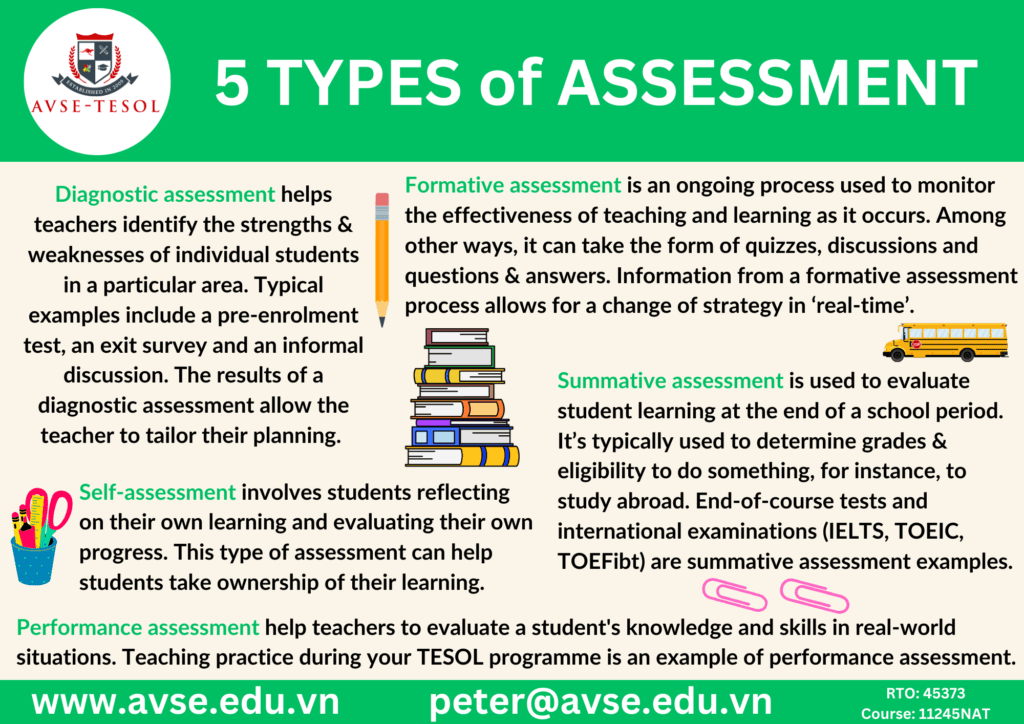
There are five primary assessment categories: 1. Diagnostic Assessment, used to identify a starting point; 2. Formative Assessment, used to monitor progress during a course; 3. Summative Assessment, used to evaluate overall progress – at the end of a study programme, 4. Self-assessment – when a person evaluates their actions, attitudes, or performance; and 5. Performance Assessment, which measures how well students apply their knowledge, skills, and abilities in real-life situations. Think about a single assessment task you were required to complete during your school, university, or college years. That task will sit under one of the five assessment types. Let’s drill down on five key assessment types:
Diagnostic:
In an ESL context, a Diagnostic Assessment is a test taken before a study programme begins to determine a student’s competence level in a specific area. The primary purpose of the assessment is to ensure that the student is placed in a suitable ESL class. Diagnostic Assessment results help teachers deliver lessons targeted to the needs of an individual student (or a group of students), providing the proper challenge and support. For example, ESL placement tests are commonly used in Vietnam and Cambodia, albeit with varying levels of success, to decide how to group students.
Formative assessment:
From the beginning to the end of a study programme, Formative Assessment, of one type or another, helps the teacher check if his (or her) students are progressing as expected and, if necessary, modify the teaching methodology appropriately. While diagnostic assessments set a baseline for learning, formative assessments are geared towards gaining insight into the progress made. Observation, quizzes, pair work, group work, weekly tests and a written assignment are all formative assessment examples that give immediate feedback on how the teacher and students are doing. Check out a super blog post about formative assessment by clicking on the image immediately below.
Summative assessment:
As the word ‘summative’ implies, this assessment process relates to the ‘sum’ of the study programme – the whole lot. It occurs at the end of a course and allows the teacher to reach an informed view of the success or otherwise of the teaching and learning that took place. Like diagnostic and formative assessment, summative assessment processes come in any number of forms; here are some random examples: a major research project, quizzes on course topics, long and short answer questions – and an end of course exam. Check out the following video from the Helpful Professor YouTube Channel:
Self-assessment:
Self-assessment is when a student evaluates his (or her) own skills and progress. It involves reflecting on strengths and weaknesses, setting goals, and identifying areas for improvement. Self-assessment is an underutilised but valuable process in ESL teaching and learning. It allows students to understand their circumstances better and make informed decisions about future actions and goals.
Performance assessment:
Your TESOL programme’s critically assessed teaching practice component is a classic example of a performance assessment process. Performance assessment evaluates an individual’s knowledge and skills while completing real-life tasks. It may involve direct observation – like what happens in a teaching practice class – practical activities or projects to measure effectiveness and achievement.
Purpose of assessment
In an overarching sense, the purpose of assessment is twofold: 1. to gather evidence and 2. to promote learning.
Suppose you accept that assessment comes in various forms – diagnostic, formative, summative and such. In that case, you’d agree that assessment serves multiple purposes. For example, a diagnostic assessment process aims to understand what the student currently knows about a subject area – and a summative assessment process seeks to understand what the student has learnt by the end of a particular study programme. While assessment serves various purposes of equal importance, the commonality among the purposes is stark.
‘Evidence’ is a glaring commonality. Assessment provides evidence – what a prospective learner knows before the class starts (diagnostic), what a learner knows at a point in time during a course (formative), what a learner knows at the end of the class (summative), and the list goes on.
Another glaring commonality is ‘promoting learning’. Armed with evidence from a valid and reliable assessment process, teachers can identify the strengths and weaknesses of students, tailor instruction to meet the needs of individual students (or the whole class) and provide targeted feedback encouraging growth and improvement. Moreover, armed with evidence, teachers can adjust their teaching methodology (resources, Student Books, learning activities and the like) to address apparent gaps – consistent with promoting learning.
Characteristics of a good test
The word search puzzle below contains 20 hidden words you would expect to hear if someone were discussing classic features of a ‘good test.’ Here are three tasks for you to complete:
1. Predict five words that might be in the puzzle
2. See how many of the 20 hidden words you can find in 10 minutes
3. Share the words you predicted – and those you found, with the person sitting beside you.
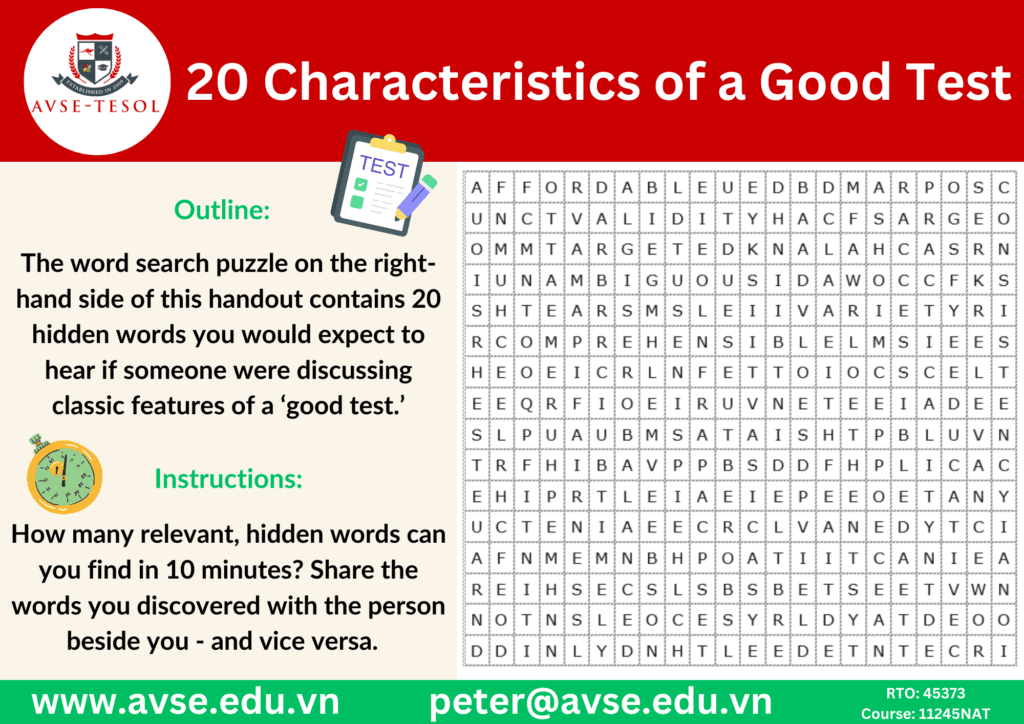
Guiding principles when selecting tests
When you’ve found the 20 keywords in the Wordsearch puzzle, I’d encourage you to select six of those words to be used as your (personal) guiding principles for choosing a suitable test moving forward. All 20 words in the puzzle are relevant and should weigh on your mind. Still, you will have done well if you settle on six words as your not negotiable ‘Guiding Principles’. Then, flesh out each word into no more than a paragraph that means something to you. With six words and related explanations, you’ll be set with guiding principles when selecting a test moving forward.
Once your ESL test selection guiding principles are established, it will be useful to identify practical steps to follow each time you prepare to deliver a test. Creating a Test Prep To-Do List can ensure that important details are systematically addressed in the lead-up to the test. This ‘To-Do List’ could serve as a guide to help you organise and streamline your preparation work. Here’s an example of a Test Prep To-Do List:
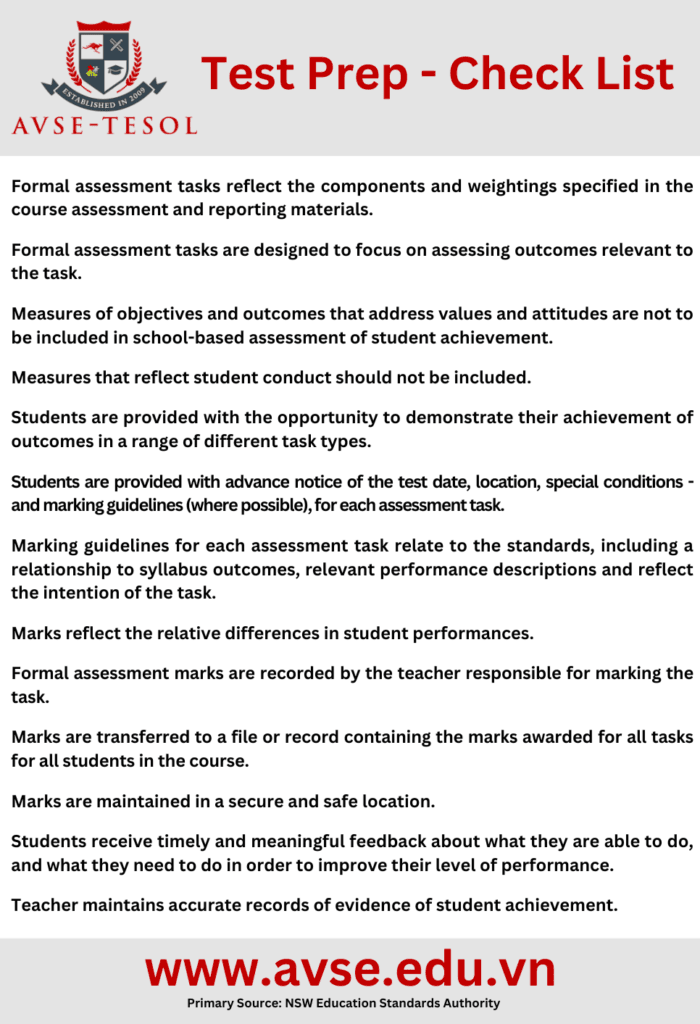
Grading tests
When grading English language tests, it’s imperative that teachers follow a predetermined, structured approach to achieve consistency and fairness – and, importantly, alignment with proficiency standards of one kind or another. For example, the proficiency standards for Test A might come from the Common European Framework of Reference for Languages (CEFR). Test B proficiency standards might come from the Australian Qualifications Framework (AQF). Proficiency standards provide benchmarks that must be achieved to justify a particular grade being recorded. Assessments based on an arbitrary approach carry zero weight because they’re about ‘opinion’ rather than factual information.
If you don’t know the word ‘rubric’, it will become like an old friend who keeps popping his (or her) head up during your ESL teaching career. In simple terms, a rubric is a scoring guide that typically includes instructions on what a student needs to do in order to achieve a particular grade. It’s an essential tool teachers have at their disposal to achieve consistency, fairness and alignment when allocating a grade. Carefully review the IELTS Speaking rubric immediately below. You’ll be asked to respond to four questions about the Speaking rubric in the next paragraph.
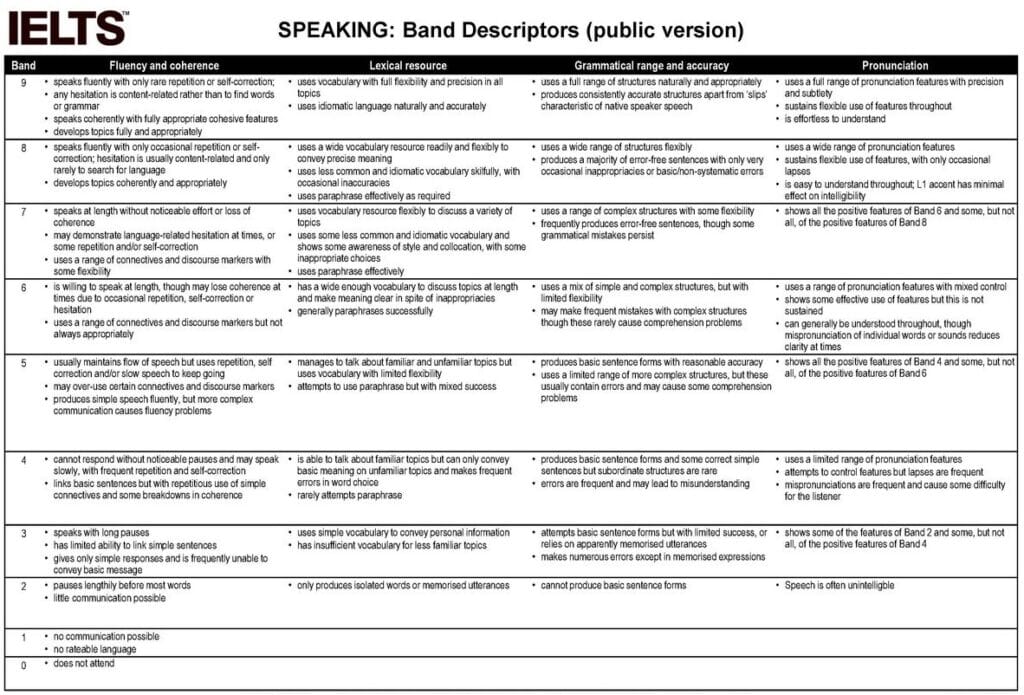
Here are four questions for you to reflect upon after reviewing the IELTS Speaking Test rubric.
1. What’s the score (Band) range for the speaking section of the IELTS Test?
2. What are the four ‘Band Descriptors’ (by name) in the rubric for the Speaking Test?
3. What would a test-taker need to exhibit to achieve an overall band score of ‘5.0’ for the Speaking Test?
4. Referring to the rubric, explain how ‘Test Taker A‘ was awarded a score of ‘5.5’ for the Speaking Test.
Grading is one of the more time-consuming components of an ESL teacher’s work. No sooner will you finish one lot of assessments than another lot requires your attention. Check out the article below from the Teacher Writer website. It provides easy-to-follow tips and hacks to reduce the amount of time (and energy) you spend on assessing work from your students – without compromising consistency and fairness – and alignment with proficiency standards:
Young Learners: Popular international tests
If your teaching English abroad journey takes you to Vietnam or Cambodia, one of the first things you’ll notice is that ESL classes for ‘Young Learners’ (4 to 17 years of age) tend to be categorised as follows: Starters, Movers, Flyers, Key English Test (KET), Preliminary English Test (PET) or First Certificate in English (FCE). You’ll typically find students 5 to 7 years of age at the Starter level. By the time a student gets to the FCE level, he (or she) will likely be 15 to 17. The six categories – Starters through to FCE – are commonly called the ‘Cambridge Model’. Most English Language Schools in Southeast Asia follow the Cambridge Model – if only because it provides ‘structure’ and a clear pathway to English proficiency. At the end of each category, students have two options: 1. they can sit for a formal ‘Cambridge’ test at the British Council office closest to where they live, or 2. do an informal test at the school or Language Centre where they studied English. Option one comes with a fee. Anecdotally, 95% of Young Learners in Southeast Asia go with option two, which means you may be a ‘Cambridge assessor’ by default.
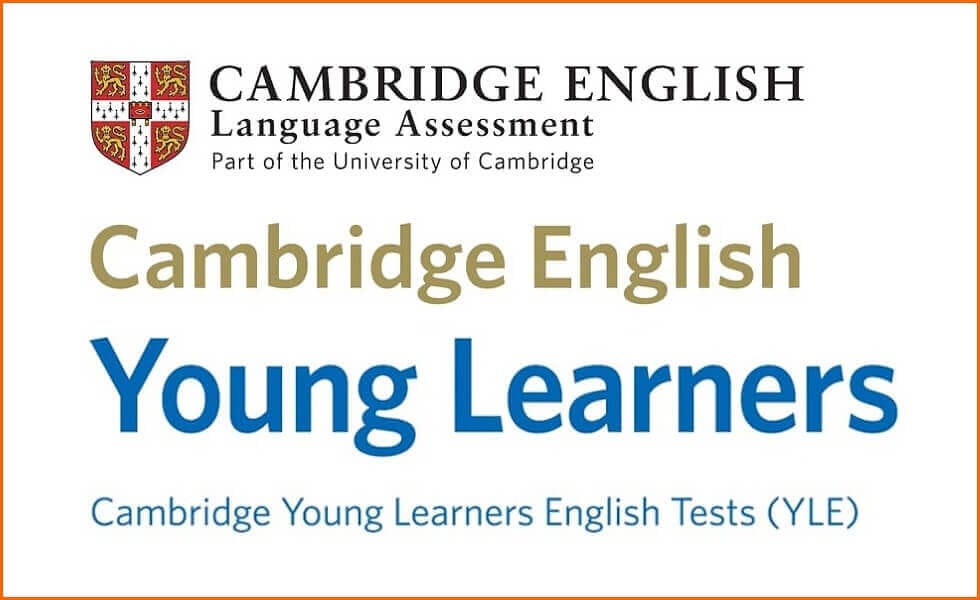
Adults: Popular international tests
There are several formal (international) tests that are used by employers, academic institutions, and immigration authorities to measure a person’s English language skills. Preparation courses for the more popular international tests, including IELTS, TOEFL iBT, TOEIC and CEFR, are a significant source of income for English Language Schools worldwide. You will encounter many students enrolled in test preparation classes during your ESL teaching career. Moreover, there’s a good chance that you’ll be asked to teach test preparation classes, especially when you have a bit of ‘coalface’ experience under your belt. Here’s a snapshot of the four most popular international tests:
IELTS:
| Full name: | International English Testing System (IELTS) |
| Country of origin: | United Kingdom |
| Ownership: | Jointly owned by the British Council, IDP IELTS, and Cambridge University Press & Assessment |
| Website: | https://www.ielts.org/ |
| Structure & time: | Four components – reading, writing, listening, and speaking in 2 hours & 45 minutes |
| Score (Bands): | Independently assessed: 0 to 9 (4.0, 4.5, 5.0….) in each of the four sections, with the final score being an average of the total achieved in each section. |
| Primary purpose: | Study abroad, work abroad, immigration |
| Helpful links: | IELTS Liz (general information): https://ieltsliz.com/ IELTS Podcast: (band scores explained): https://www.ieltspodcast.com/ielts-exam/ielts-band-scores/ IELTS Asia: (great tips): https://www.ieltsasia.org/hk/en/prepare/toptips |
| Fee: | Yes, varies from country to country |
TOEFL ibt:
| Full name: | Test of English as a Foreign Language – internet-based training (TOEFL ibt) |
| Country of origin: | United States |
| Ownership: | English Testing Service (ETS) |
| Website: | https://www.ets.org/ |
| Structure & time: | Four components – reading, writing, listening & speaking in 1 hour & 56 minutes |
| Score: | Independently assessed: 0 to 120, with each of the four sections offering a maximum score of 30 (4 x 30 = 120) |
| Primary purpose: | Study abroad, work abroad, immigration |
| Helpful links: | UK Study Online (general information): https://www.ukstudyonline.com/toefl-ibt-test-explained/ Class Central (resources): https://www.classcentral.com/report/toefl-preparation/ Global Exam (resources): https://global-exam.com/blog/en/resources-toefl-ibt-training/ |
| Fee: | Yes, varies from country to country |
TOEIC:
| Full name: | Test of English for International Communication |
| Country of origin: | United States |
| Ownership: | English Testing Service (ETS) |
| Website: | https://www.ets.org/toeic |
| Structure & time: | Three options: 1. TOEIC Listening & Reading (workplace skills) x 150 minutes, 2. TOEIC Speaking & Writing (workplace skills) x 80 minutes, 3. TOEIC Bridge (English skills x 4 for everyday use) x 112 minutes |
| Score: | Independently assessed: 1. Listening & Reading Test, 0 to 990, 2. Speaking & Writing Test, 0 to 200 for each test (2 skills), 3. Bridge, 0 to 50 for each test (4 skills) = 200 |
| Primary purpose: | Job placement, university/college graduation requirement in some countries, everyday life |
| Helpful links: | Quizlet (resources): https://quizlet.com/content/toeic-exam-faq Q Language (tips): https://www.qlanguage.com.hk/how-to-pass-toeic/Business English – Allure: (Q & As): https://www.businessenglishallure.com/what-is-the-toeic-test-all-your-questions-answered/ |
| Fee: | Yes, varies from country to country |
CEFR:
| Full name: | Common European Framework of Reference for Languages (CEFR) |
| Country of origin: | France (Strasbourg) |
| Ownership: | Council of Europe (separate from the European Union) |
| Website: | https://www.coe.int/en/web/common-european-framework-reference-languages |
| Structure & time: | The CEFR doesn’t offer tests as such. It provides guidelines to assess and standardise language proficiency across various languages, including English. CEFR guidelines provide a structured way to evaluate language skills across six levels of competence – beginner to proficient (A1, A2, B1, B2, C1, C2), with A1 being the lowest and C2 being the highest. |
| Score: | Independently assessed – mapped to CEFR guidelines. |
| Primary purpose: | Job placement locally and abroad, study abroad, immigration |
| Helpful links: | Cambridge (guide): https://www.englishprofile.org/images/pdf/GuideToCEFR.pdf Trinity (six levels): https://www.trinitycollege.com/qualifications/SELT/CEFR Language Formula (opinion): https://www.thelanguageformula.com/articles/cefr-language-levels |
| Fee: | Yes, varies from entity to entity |

Typical questions from students about international tests
Students will assume you’re a ‘guru’ with international tests by virtue of your teacher status. Therefore, putting time aside to learn about the intricacies of the more popular tests is a good idea. Try to know the key features of popular tests – and their strengths and weaknesses. If you’re asked a question about an international test, be factual rather than advising students on what test is best for their personal circumstances. Importantly, students should be encouraged to consult widely before pursuing an international test, if only because of the high-cost factor and the amount of work. Immediately below, you will see a list of questions about international English tests that an ESL student might ask you. If asked, how would you respond? ‘Forewarned is forearmed’ as the age-old saying goes.
1. I’m thinking about studying abroad. Which international test should I take?
2. I’d like to work for a foreign company. Which international test should I take?
3. What’s your opinion of the IELTS/TOEFL iBT/TOEIC/CEFR test?
4. Tell me about the structure/time of the IELTS/TOEFL iBT/TOEIC/CEFR test?
5. Where can I take the IELTS/TOEFL iBT/TOEIC/CEFR test?
6. What’s the cost of the IELTS/TOEFL iBT/TOEIC/CEFR test?
7. Can you explain how the IELTS/TOEFL iBT/TOEIC/CEFR test is scored?
8. Do my test results have an expiry date?
9. How can I improve my listening/speaking/reading/writing skills for the IELTS/TOEFL iBT/TOEIC/CEFR test?
10. I want to live permanently in Australia/the United States/the United Kingdom/Canada. Will I have to take an English test to get a visa? If so, which test?
Preparing your students for English proficiency tests
If preparing a group of students for an international English test is on your agenda, you’ll need to know a thing or two about the particular test. Getting up to speed will almost certainly involve a lot of work, but there will be tangible benefits for you and your students. Visiting the website address for each test I’ve noted above is an excellent place to start.
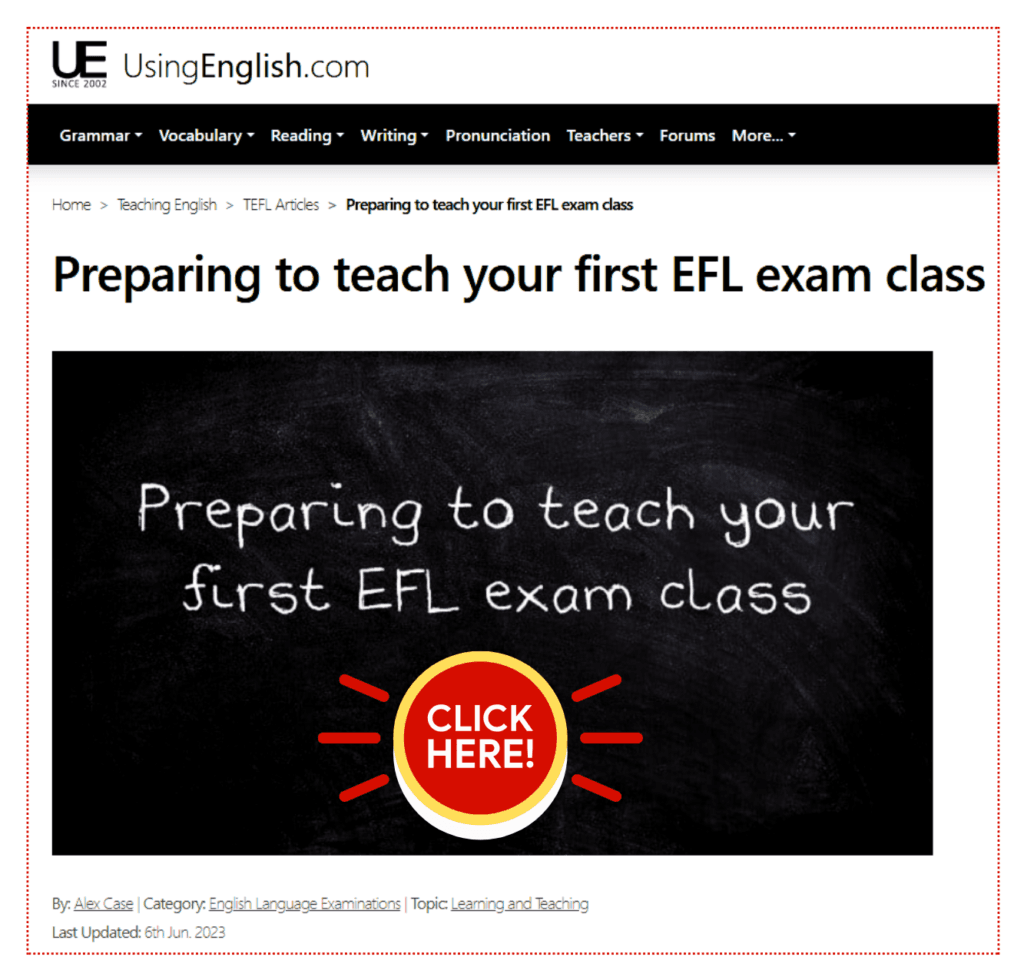
Remember that test preparation classes are not directed at building English skills, although that might happen; they’re directed at 1. building test-taking strategies to maximise the score and 2. familiarising students with what to expect – structure, scoring mechanism and the like. Achieving ‘guru’ status with test-taking strategies is an area where you can distinguish yourself as an ESL educator. The good news is that plenty of folks have been down this path beforehand. Consequently, the internet is full of test-taking strategies you can hone for your audience. Master the strategies and then pass them on to your students. They’ll think you’re a superstar!
How about replicating ‘test-like’ conditions (with the relevant scoring mechanism) for a specific time in each preparation class, say 20 minutes? You’ll find ‘sample’ IELTS, TOEFL iBT, TOEIC, CEFR tests, questions, ‘ideal’ answers, relevant social media support groups and online. More information is available than you’ll ever have time to take in.
Some folks thrive in ‘test’ situations – international or otherwise – others are carefree. Then there are people like me with a history of ‘buckling at the knees’ in a test scenario. Every student is important, and regardless of the score achieved on a test, the sun will come up tomorrow. ESL teachers have a responsibility to convey this crucial message. Knowing that your student gave the test his (or her) best shot is a success story by any measure.
Sample ESL Tests
In this video below, you will find a ‘secret’ database of 61 websites with sample ESL Tests and related resources that might be helpful as you embark on your ESL career. It’s well worth a look.
Concept Checking
Is Concept Checking another type of testing? I think so, but it’s less formal – it can be as simple as a brief question and answer – and the purpose differs from the conventional forms of testing we’ve considered in this module so far.
‘Concept Checking’ involves assessing whether a student or group of students genuinely understands what was presented to them. In an ESL class, the target of a concept-checking action might be a vocabulary word, a grammar point, a correction, instructions, an administrative matter or something else where the teacher feels it necessary to confirm understanding. Concept checking in an ESL context mainly occurs in a question-and-answer format (a Concept Checking Question or CCQ). However, the ‘concept checking’ method that’s used is limited only by the teacher’s imagination. With the complexity of second-language acquisition, everything that happens in an ESL class is ‘fair game’ for concept checking.
When to Concept Check:
Concept Checking is an ongoing process throughout a lesson – from when the first student enters the classroom until the last student leaves.
Regardless of their years of service and expertise, teachers cannot assume that every student fully understands what was said, presented, or discussed during the lesson. While it’s not unique to ESL instruction, some students learn new things quickly, and others need more time. Concept Checking, whether by CCQ or another method, is the principal mechanism that ESL teachers can use to ensure all students progress together and understand what has been put in front of them.
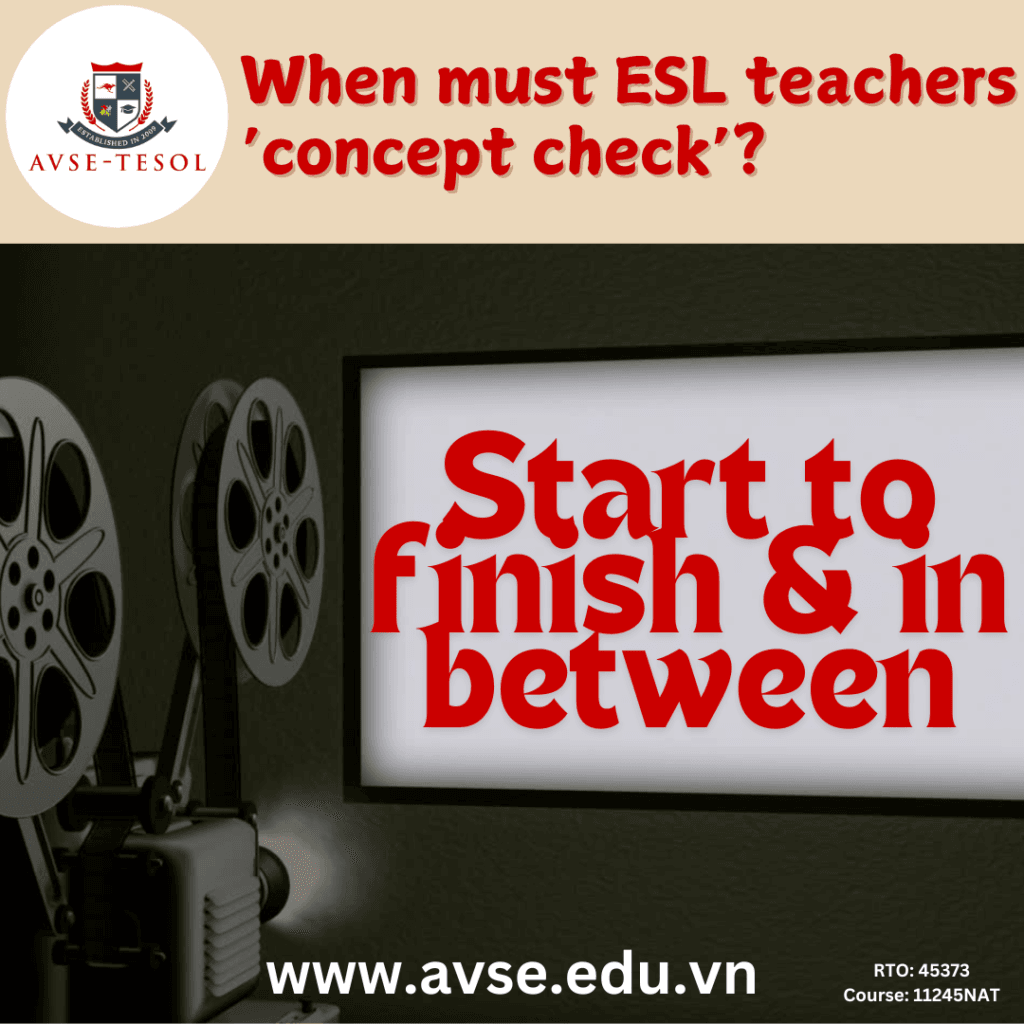
How to Concept Check:
While academic approaches often emphasise the importance of structuring Concept Checking Questions (CCQs), there are many valid ways to check understanding. Almost any method used to present material can also be adapted for concept checking. In addition, test formats, including diagnostic, formative, summative, performance-based and even self-assessment, all come with a concept-checking dimension. From my experience in ESL classes in Vietnam and Cambodia, observation is the least intrusive form of concept checking, and a final (summative) examination is at the opposite end of the ‘scale’.
In the following video, Ms Jo Gakonga (Managing Director and founder of ELT Training) shares seven methods (beyond CCQs and observation) that can be used in your ESL class to confirm whether students have understood the lesson content:
Practical Concept-Checking Questions (CCQs):
Let’s take a closer look at Concept Checking Questions, given they’re a staple of ESL teachers worldwide. In doing so, it’s important to recognise that CCQs are only one of many tools teachers have available to check for understanding.
Concept Checking questions (CCQs) should be carefully designed to reflect the new material and the student’s language skills. These questions can confirm whether students understand what has been presented without needing them to explain it in abstract terms. Moreover, well-worded CCQs also provide insight into the effectiveness of the teaching strategies that were used, offering valuable information that can help teachers adjust their approach to better meet the needs of their students in the future. Check out the following video that explains in plain English how Concept Checking Questions (CCQs) are a valuable tool for ESL teachers:
Here is an example of a simple CCQ process, the like of which takes place every day of the week in English Language Centres worldwide:
Setting: The teacher uses PowerPoint to show a clear image of a blue sofa and other furniture items. When each image is displayed, the teacher elicits the vocabulary word from the group and delivers encouraging feedback. The teacher drills each vocabulary word chorally x 5 and then individually x 5, delivering encouraging feedback.
CCQ: The teacher points to the sofa image and asks, “Bill, what is it”?
Response: It’s a sofa.
Outcome: The teacher delivers encouraging feedback. The teacher is confident that Bill knows the word sofa and can pronounce the word with a reasonable level of accuracy. Bill and the teacher feel good about the question-and-answer exchange.
Follow on CCQ: The teacher points to the sofa again and asks: “Bill, what colour is the sofa”?
Response: It’s blue, it’s a blue sofa.
Outcome: The teacher delivers encouraging feedback. The teacher is confident that Bill knows the word blue and can pronounce the word with reasonable accuracy. Equally important, all participants in the CCQ exchange feel positive about the outcome.
Here are some more examples of CCQs that are likely to provide insight into whether a student has grasped the concept:
– CCQ: What month is it now?
– CCQ: How would you rephrase the sentence using the present tense?
– CCQ: Can we use last autumn for an event happening now?
– CCQ: When do we use ‘their’, ‘there’ and ‘they’re’?
Here are some examples of CCQs that missed the mark completely:
– Do you understand?
– Have you got it?
– Are you with me?
– Do you like to travel?
Do you agree that the questions immediately above miss the mark? If so, why?
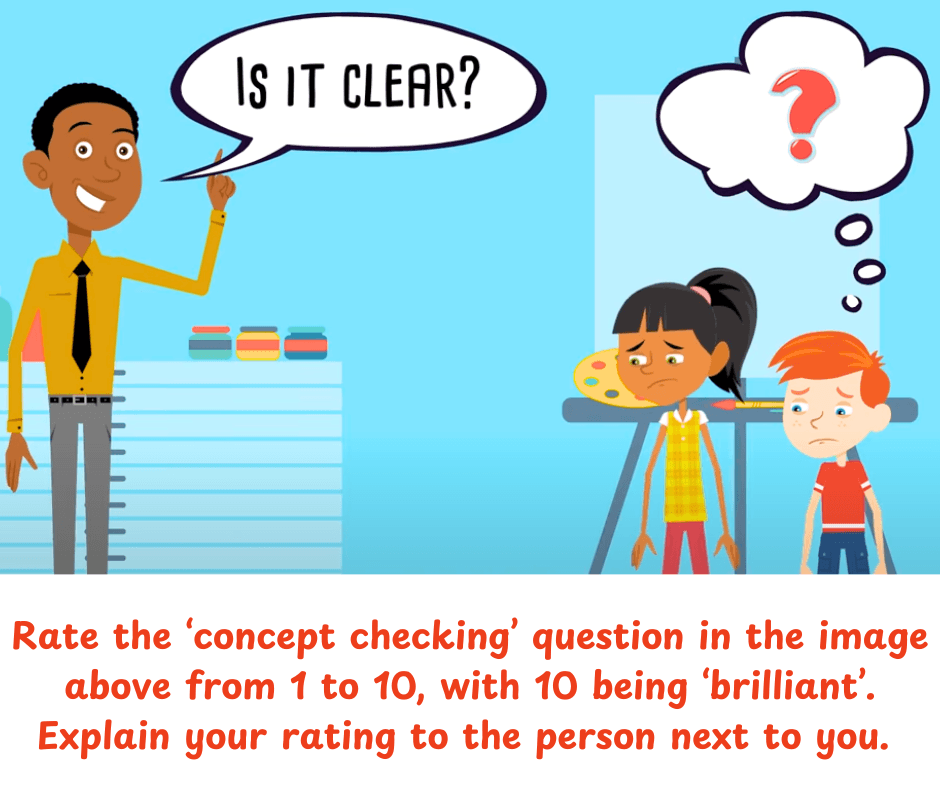
CCQ – Hot Tips:
Well-crafted CCQs are a powerful tool, yet many ESL teachers miss the chance to use them effectively. Often, CCQs are asked spontaneously rather than being thoughtfully prepared. Framing CCQs is both an art and a science; the best way to improve is through practice and continuous refinement. Here are 12 ‘CCQ Hot Tips’ for consideration:
- Include key CCQs in your lesson plan. Planning your CCQs ahead of time helps ensure clarity and purpose.
- Keep your CCQs simple. Simple, straightforward questions increase the chances of students understanding and responding correctly.
- Direct your CCQ to a specific student. This avoids awkward silences and prevents the same students from answering every time.
- Don’t leave a student hanging if they don’t know the answer. Encourage them to ask a classmate for help or quietly provide the answer for them to repeat, turning it into a positive, supportive experience.
- Use various question types—yes/no, either/or, and ‘why’ questions. Mixing question types keeps lessons dynamic, enhances skill development, and reduces boredom.
- Avoid unfamiliar vocabulary or structures in CCQs. This ensures students can focus on the Concept being checked without getting confused by new words.
- Cover all aspects of the target concept in your CCQs. For instance, asking if you can “cook food in it?” (referring to an oven) may require follow-up questions to differentiate between other cooking tools like a saucepan.
- Use visuals or gestures to support your CCQs. For example, pointing to an object or miming an action clarifies the question, especially for beginner learners.
- Pace your delivery. Give students time to think before answering. Rushing them may lead to confusion or an incomplete response.
- Repeat or rephrase if needed. If students seem unsure, calmly rephrase or repeat the question using more straightforward language or structure.
- Engage multiple students in the same CCQ. After one student responds, ask others if they agree or what they would add. This keeps the whole class involved and reinforces learning.
- Keep CCQs relevant to real-life situations. Relating questions to students’ daily lives or experiences makes the material more engaging and memorable.
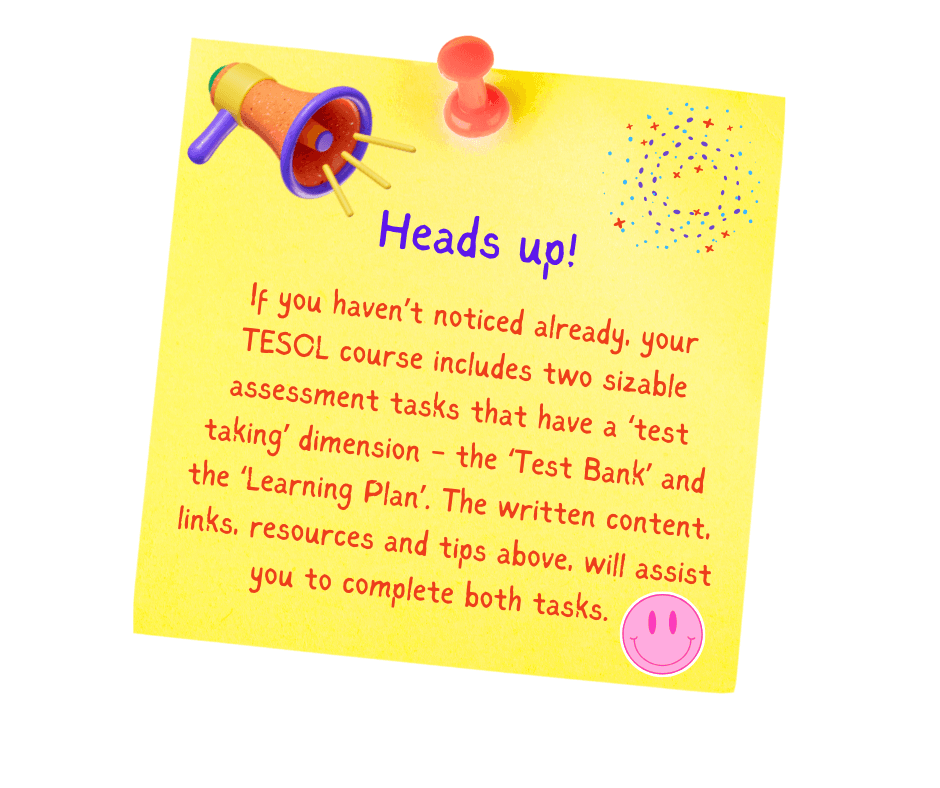
Presenting Material in an ESL Class
Preface:
The French have a term, ‘enfoncer une porte ouverte’, which translates as ‘Pushing open an already open door,’ its meaning is similar to the English phrase, ‘Stating the bleeding obvious.’ Presenting information engagingly and understandably is a crucial responsibility of all teachers – especially in the ESL industry, where the goal is to make language accessible and meaningful for learners. An effective presentation involves delivering content and engaging students through clear explanations, visual aids, and interactive activities. Presentations must capture attention, maintain interest and be comprehensible. In ESL classrooms, effectively presenting information generally requires breaking down language structures, modelling correct usage, and using real-life examples.
Teachers facilitate understanding by scaffolding learning, adjusting their methods to suit different proficiency levels, encouraging active participation, and making the language acquisition process more dynamic and student-centred. As someone new to lesson planning and probably facing the prospect of presenting the content of your lessons in front of an audience regularly for the first time in your life, you’ll discover students make up their minds about a teacher in a remarkably hasty fashion. You can gain their trust and cooperation by paying close attention to the information at the heart of your syllabus and the professional and conscientious way you present it.
Presentation Methodology:
Presentation methodology in ESL focuses on how teachers deliver language instruction to make it engaging and comprehensible for learners. In an ESL context, presentations are more than just giving information; they involve interactive strategies that help students understand, remember, and use new language concepts. Effective presentation combines clear explanations, visual aids, real-world examples, and various techniques to encourage student participation. You can deploy two methods to put new material in front of your students: Telling them ‘What’s what’ – best clarified in German as ‘Jemandem reinen Wein einschenken,’ literally translating to pouring someone pure wine, but figuratively, it means to say something like it is. My preferred method is asking them, ‘What’s what’. Telling them is straightforward but becomes very ‘teacher-centred’, and the class quickly devolves into a lecture. Asking them—where the teacher is a facilitator—is more learner-driven. Asking them is consistent with what’s commonly referred to as ‘active learning’, where students tend to acquire a deeper understanding of the subject at hand.
Presentations often incorporate multimedia resources to make the language more vivid and relatable, and teachers may use gestures, body language, and repetition to enhance understanding. ‘Differentiation’ is another characteristic of a presentation that has been well-planned. Teachers modify their presentation methodology to suit different learning styles or language proficiency levels. For example, teachers might use visuals and simplified language for lower-level students. In contrast, higher-level students may benefit from more complex discussions and cultural references. Ultimately, presentation methodology in ESL is about making language learning accessible and enjoyable. It aims to bridge the new language and the learner’s existing knowledge by presenting information understandably and engagingly, allowing students to gradually move from passive observation to active language use. This methodological approach helps foster language acquisition and encourages learners to use English confidently in various contexts.
Active learning in ESL involves engaging students directly in the learning process through meaningful activities and tasks rather than passively receiving information. The goal is to encourage learners to actively construct knowledge, develop critical thinking, and practice language skills in authentic contexts. In active learning, students participate in activities such as discussions, problem-solving, and collaborative projects that require them to use the target language.
Role-playing is a great example of active learning. Role-plays simulate real-life situations where students must use conversational English, like ordering food at a restaurant—or arguing with a customs officer at airport immigration. Another example is group debates, where students present and defend different viewpoints, fostering speaking skills and spontaneous language use. The Oxford Debates involves a longstanding tradition of debating. While it’s certainly more often suited to very advanced students, successful participation in an Oxford Debate can improve their confidence. Peer teaching also encourages active participation by having students explain grammar rules or vocabulary to each other, reinforcing their understanding.
Active learning can also involve task-based activities, such as planning a trip or conducting a survey, where language use is necessary to complete the task. ‘Think-pair-share’ activities, where students discuss questions with a partner before sharing with the class, can help lower anxiety and build confidence. Using active learning strategies, ESL teachers make lessons more interactive and student-centred, promoting language retention and practical usage. This approach transforms students from passive listeners to active participants in their language-learning journey.
Being creative when presenting material in a classroom is where many ESL teachers excel. Still, there are plenty who need to improve. Assuming you wish to be in the ‘excel’ camp, the goal should always be to provide a dynamic learning environment where the target language is presented in multiple ways to suit different learning styles. It’s easy for teachers to fall into staid, repetitive classroom presentation modes. It may be a truism to say you can present material to your students however you want; just don’t bore them.
Regardless of the presentation techniques you use in a particular lesson, remember that it’s imperative to cater to different learning styles – auditory, visual, social, and the like. Equally important, you need to capture and hold your students’ attention for the duration of the lesson. Easy? It’s not easy, but it is achievable. If you take nothing else from this Module in your TESOL course, I hope the following advice resonates with you:
- Ensure your ESL presentations from this day forward are consistent with the ‘active learning’ ethos.
- ‘Scaffold’ the active learning experience with an appropriate mix of short, sharp learning activities directed at achieving the desired teaching and learning outcomes.
- Make inclusivity, student engagement and use of information technology your ‘calling cards’ as an ESL teacher.
Presenting to Adults:
There’s a sizable proportion of new ESL teachers who arrive in Vietnam or Cambodia with the expectation – through personal preference or naivety – that they will teach adults. If you’re one of those people, it will quickly become evident that 90%+ of ESL job opportunities in Vietnam and Cambodia involve young learners. If you’re serious about filling your schedule with paid teaching hours, you’ll need to be available to teach all ages and skill levels – at least initially. From my observations, it becomes apparent to many who initially thought they were best suited to teaching adults that teaching kids is much easier and more rewarding. Smiling and delivering engaging ESL lessons make succeeding in a kid’s class relatively easy. In contrast, adults are much harder to please and have unique challenges and expectations – on this point, Robert Knowles’ Andragogy Theory (published in 1980, revised in 1984) is well worth reviewing – click on the link immediately below.
Teaching adults: common presentation techniques
Here are the four most common ESL presentation techniques with an active learning dimension used worldwide when teaching adult learners.
Whiteboard: I spent a long-time using whiteboards before I thought of them as having much over a blackboard and chalk. Then, I realised they are a highly versatile tool in our classrooms. It can be used to illustrate grammar rules, write new vocabulary, and draw diagrams to explain complex ideas visually. Colour-coding different parts of speech or sentence structures helps to visually organise information and make it easier for learners to follow. Teachers can interactively build content on the board, allowing students to see the progression of the lesson (scaffolding ‘101).
Whiteboards are especially useful during brainstorming sessions, where students contribute ideas, and the teacher writes up. Better still, ask a student or two to record contributions on the whiteboard during a brainstorming session.
Realistically, many schools in countries like Vietnam and Cambodia don’t have whiteboards, not because they don’t want them, but rather for economic reasons. You may have to make do with chalk and a homemade blackboard. It’s all part of the adventure!
Peer teaching: Peer teaching, the idea of students teaching each other, is seemingly eternal. Still, it only gained prominence in the 1990s, initially on the West Coast of the United States. Peer teaching is an active learning approach that empowers students to take responsibility for their learning by explaining concepts to their peers. How’s it done? Suppose your students are learning new vocabulary. You’d put the students in pairs, and they’d work through the meaning, correct pronunciation and usage with each other. It’s an attractive alternative to a teacher ‘banging on’ at the front of the classroom, boring everyone to tears. With peer teaching, the student-to-teacher speaking ratio, even with instructions given by the teacher, will be near 90% / 10%, consistent with the active learning ethos.
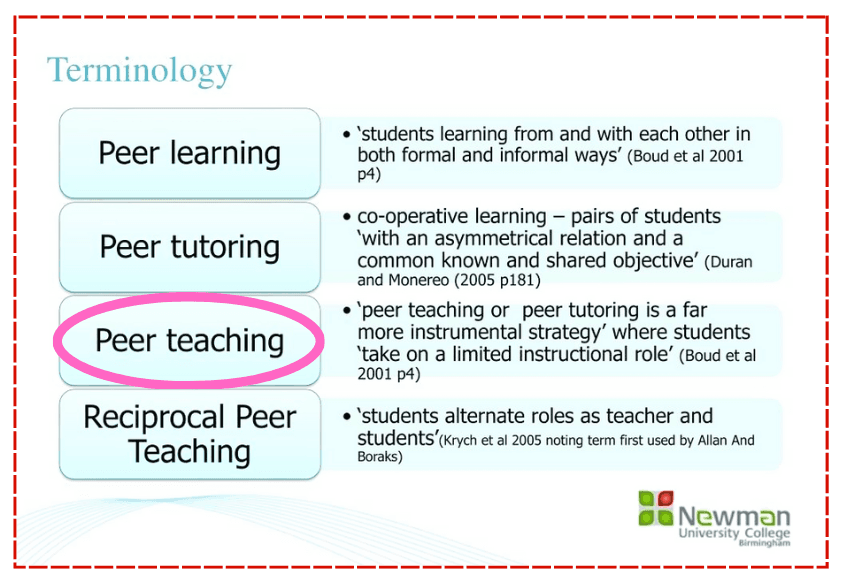
Worksheets: I use, you will use, and every ESL teacher I’ve ever met uses worksheets. It’s true that worksheets mostly appear in an ESL lesson’s Practice and Produce phase, but when used astutely, worksheets are equally beneficial when presenting new material. How? Picture this. Your target vocabulary words for today are six animals you’d find in a zoo. You hand out a worksheet that focuses on the six animals. Put students into pairs, not the person next to them, which means half the class needs to move chairs. How can you arbitrarily do this this? It’s easy. Let’s say there are twelve students in the class. Starting from the left, number students one to six. Then, continue with numbers one to six for the remaining students. Ask the two ‘number one’ students to sit together, the two ‘number two’ students to sit together and so on. Already, students are active and engaged.
Next, ask the students to work with their partner to complete the worksheet – two brains, one worksheet; there’s a good chance they will get through it. The teacher roves, ensuring everyone is on track, provides a helping hand where necessary and gives plenty of encouraging feedback.
Before correcting the worksheet as a whole class, you ask each pair to check their answers with the pair closest to them – more active learning and engagement. One at a time, ask a student from each pair to write the word for one of the zoo animals (referenced in the worksheet) on the whiteboard – continue until all the target words are listed on the whiteboard.
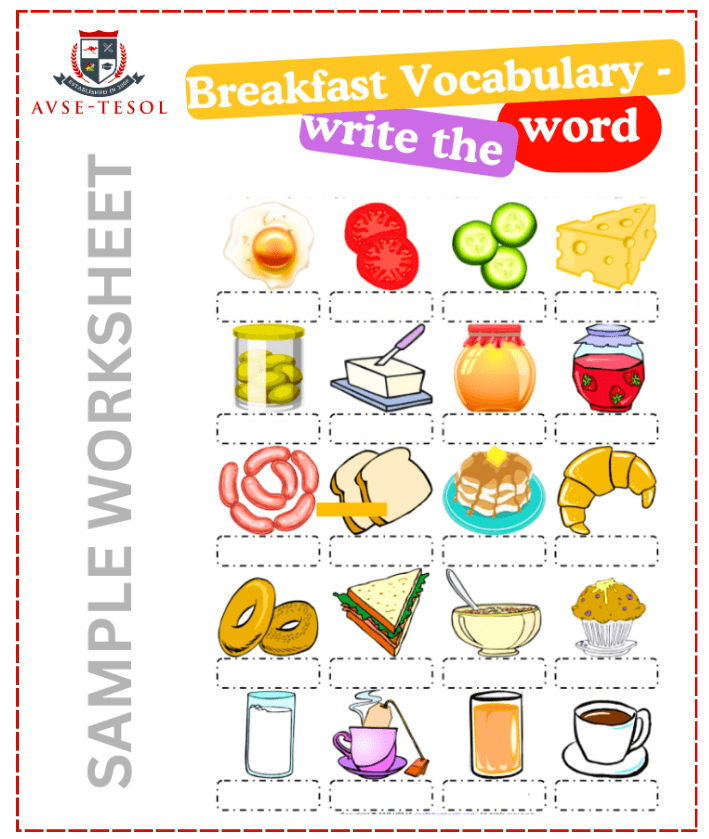
What’s the outcome here? The six target vocabulary words for the lesson have been put in front of the students – they’ve identified the words – and written them on the whiteboard. The target vocabulary has been presented, with ‘teacher-talk-time’ kept to a minimum. Yes, more work must be done, such as pronunciation, concept checking, and the like. Still, you’ve used a worksheet in an ‘active learning’ manner – that effectively required the students to present the target vocabulary for the lesson – with teacher talk time kept to a minimum.
Drilling: In our business, drilling is not putting holes in a bit of timber or a subgenre of Hip Hop; it involves the repetitive practice of language structures or vocabulary to reinforce learning. It is especially effective for vocabulary, pronunciation, sentence patterns, and grammar points. Teachers might use drilling to help students grasp tricky sounds, practice correct intonation, or memorise common expressions. Drills can be conducted collectively, with the whole class repeating after the teacher or individually, where each student practices the phrase aloud. Although drilling is a more ‘old school’ approach with plenty of detractors, it can be highly effective for building language accuracy. From my experience, drilling is especially effective with beginner-level classes.
Powerpoint: PowerPoint presentations provide a visual and multimedia-rich method of delivering content in ESL lessons. Slides can include text, images, audio, and video, which make the presentation more engaging – and cater to various learning styles. For example, a PowerPoint presentation about the weather might include slides with weather-related vocabulary, audio of people talking about the weather where they live, a short video about an extreme weather event, and more. The use of animations and transitions helps to emphasise important points. PowerPoint is an exceptionally versatile teaching tool. Throughout my ESL teaching career in Vietnam and Cambodia, I used PowerPoint daily, mainly when introducing new topics, reviewing vocabulary and summarising a lesson. Nowadays, ESL students expect their teachers to be proficient with PowerPoint. If PowerPoint is outside your current skill set, I’d strongly encourage you to invest in some targeted training at the earliest opportunity.
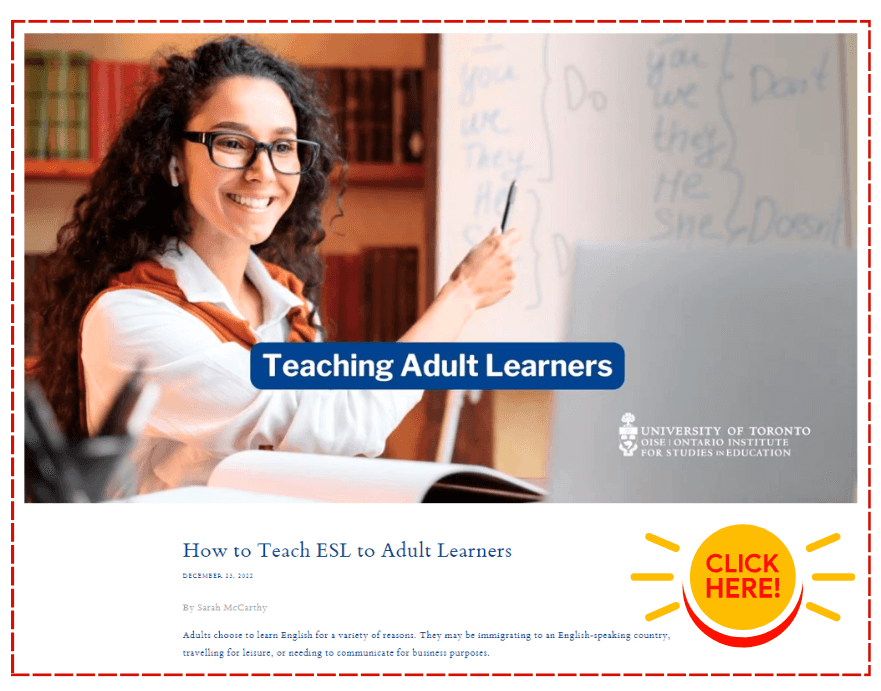
Challenges with presenting to adults
The biggest challenges with presenting material to adult ESL learners, in my opinion, are sixfold: time constraints, personal motivation, diverse skill levels, retention of information, confidence, and culture. Let’s drill down on these six challenges and proffer solutions for each scenario.
Time constraints: most adult ESL students will balance competing priorities, including employment, family commitments, social life, and ‘me time’. When you add ‘completing an English language course’ to what is already a full schedule, that’s a lot for one person to take on, but many folks do. ESL teachers can extend a helping hand by, among other things:
- Maximising in-class time with meaningful activities that directly target the learning objectives of the student.
- Exhibiting flexibility and patience.
- Delivering plenty of encouraging feedback.
- Thinking ‘outside the box’ to achieve ‘real-life’ practice opportunities.
Personal motivation: Studying English with a particular purpose in mind, is commonplace among adult ESL students. The purpose might be career advancement, to move to an English-speaking country, or to study abroad. This strong sense of purpose often translates into a high level of motivation, which is terrific. However, this strong sense of purpose can give rise to challenges if the student feels the learning experience isn’t aligned with their needs – too slow, too fast, unengaging, or simply not hitting the mark.
If an adult learner is disillusioned, there’s a high chance that you, his (or her) classmates, and your Director of Studies will hear about it. Assuming the unhappy student’s feedback is delivered professionally, it can be valuable for shaping a more tailored and satisfying learning journey. Keep in mind, a student complaint isn’t always fair or accurate. When the student has a legitimate point, it can be a learning experience for the teacher. On other occasions, where a complaint is unfounded, it’s essential for the teacher to respond in a professional manner at all times.
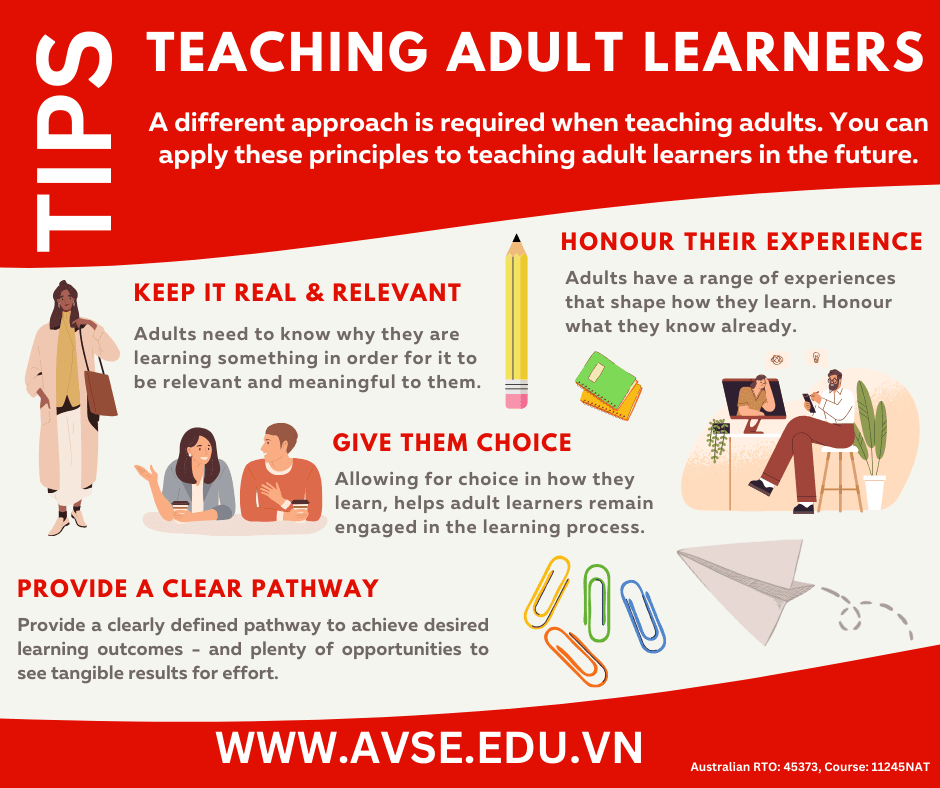
It’s essential for teachers to take time to understand their students and their real-life goals. With this insight, they can adapt lessons to fit the needs of individual students better. In an adult ESL class, not all students share the same motivations, so the challenge becomes: how can a teacher keep everyone engaged and satisfied? Here’s how:
- Inclusivity: every student needs to feel ‘valued’ by the teacher.
- Set personal goals.
- Encourage (and actively facilitate) self-directed learning.
- Ensure the learning material is relevant to all students, for example, based on real-life, everyday scenarios.
Diverse skill levels: Given that less than 10% of the ESL market worldwide is adult learners, resulting in the availability of fewer classes, there’s a greater chance that a cohort of adult students will be a ‘mixed bag’ regarding skill level. In Vietnam and Cambodia, it’s common to have adult students at the beginner level enrolled in the same class as students with a much higher English proficiency. Tough? Absolutely, but whining to the Director of Studies or similar at your school about the diversity of skill levels in a class will not enhance your ongoing employment prospects. It is what it is, as the adage goes. What can you do with a scenario of this kind? You may wish to consider the following:
- Use differentiated learning – the same task, but a range of difficulty levels.
- Peer teaching, having those students with a higher level of English proficiency teaching and supporting students with a lower level of proficiency – it’s a win-win scenario.
- Promote independent learning, creating opportunities for all students to build upon their existing skill level.
- Include open-ended activities (no fixed answers) in your lesson plans where students can work at their skill level.
Retention: Unlike young learners whose brains are seemingly wired for language acquisition, from my observations, adult ESL students find it more challenging to grasp new grammatical structures and vocabulary. There can be several reasons for this phenomenon – age, being preoccupied with other matters, studying habits, and so on. In addition to ensuring that every lesson is engaging and fun, what else can an ESL teacher do to promote retention?
- Allow ample time for repetition and review. Incorporate strategies that encourage the deeper processing of new information, such as contextualisation and real-life language application outside class.
- Set personalised learning goals and strategies for each student.
- Incorporate visuals and memory aids into every lesson, such as flashcards, images, and infographics, which make vocabulary, grammar structures and the like more straightforward to remember.
- Encourage students to explore opportunities to improve their memory. Techniques such as mind mapping and chunking (grouping different bits of information together) can help with organising and holding onto information.
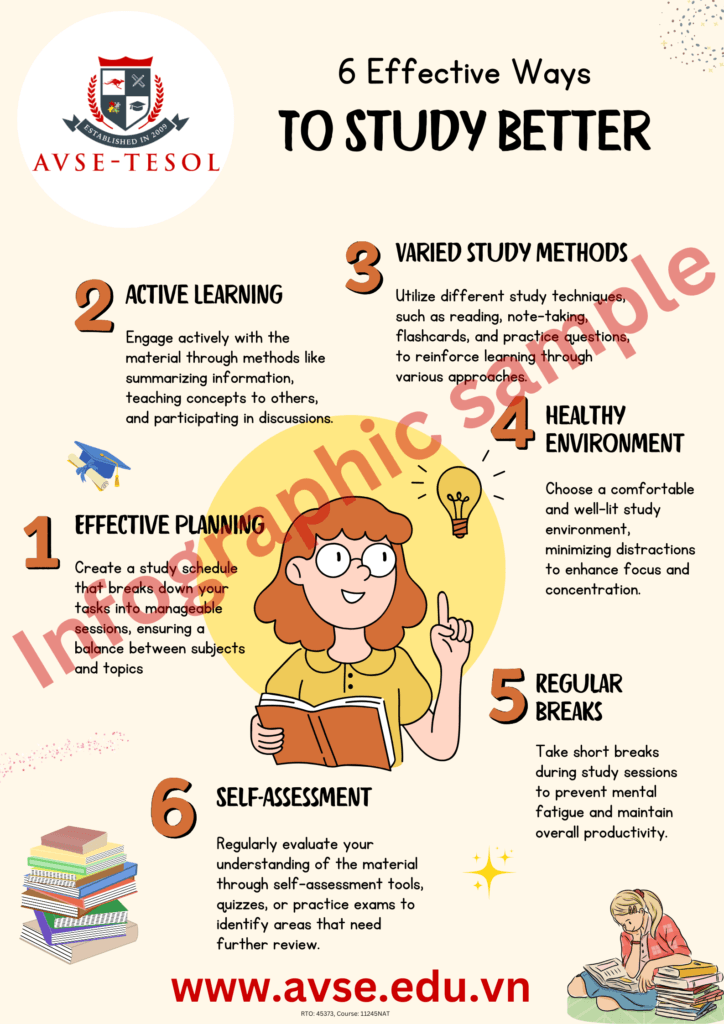
Confidence: Adult learners often feel self-conscious and, based on my observations, are more likely than younger learners to worry about making mistakes, especially in group settings. This fear of failure and the possibility of embarrassment can hold them back from participating in class. Ironically, it’s been the more naturally extroverted adults I’ve taught who’ve had a more significant problem with self-consciousness or fear of making mistakes in front of their classmates. How can ESL teachers help adult students who seemingly lack confidence? Check out the following points:
- Foster a supportive, non-judgmental environment to help reduce anxiety and build confidence. Students need to feel safe in the classroom. They need to know that it’s okay to make mistakes.
- Pair and small group work are terrific for building confidence among adult learners.
- Positive (and regular) feedback is a simple, but highly-effective confidence booster.
- Provide students with a clear pathway to English proficiency and opportunities to see tangible results for their effort.
Culture: There’s a high chance that a cohort of adult ESL learners in a country like Vietnam or Cambodia have been through an education system markedly different from their foreign ESL teacher. In this event, uncertainty about everything from classroom norms to language use will prevail. In my opinion, foreign ESL teachers have an absolute obligation to adapt their teaching to meet the needs of the local culture rather than expecting the local culture to adapt to meet their needs. The latter is not only impolite, but it’s unprofessional. If you accept this premise, an obvious question is: what’s involved in being culturally sympathetic in ‘country XYZ’? Consider the following points:
- Understand your own culture and learn about the culture in the country where you’re teaching – perspective is a good starting point.
- Interact with local people outside of the school community – listen intently and observe what’s happening around you without judgment.
- Speak with other foreign teachers living and working in the same country as you.
- Reach out to your director of studies, the school principal or similar for guidance.
- Share what you have learned with local people and other foreigners – and be receptive to feedback.
- Actively participate in staff meetings at your school.
- Seek guidance in online chats and forums.

Presenting to Young Learners:
Young learners comprise over 90% of the ESL teaching market in Vietnam and Cambodia. Presenting to kids can be a rewarding experience or your worst nightmare. Keeping young learners engaged is pivotal. In the main, children are easy to please but can be unpredictable. You can never tell what they’re going to do next. Planning and delivering ESL activities for young learners requires attention to detail, creativity, and preparedness to adapt if necessary. If Plan A is falling flat, you must be ready to switch to Plan B without anyone knowing you’ve adopted a different strategy. Equally important is ensuring smooth transitions between activities to keep your students on track because children typically have a lower tolerance for inactivity than adults.
When preparing materials, it is crucial to consider the learners’ characteristics. Their age, level of English proficiency, and previous exposure to the language will inform your choice of activities. If you’re familiar with the class, you might already have insights into their preferences. If not, consult other teachers who know the students to help guide your planning. Kids are like sponges – they soak up new information. Witnessing tangible results for your effort is one of the many joys of working as an ESL teacher, but your lessons need to hit the mark.
Heed the following words – don’t create everything from scratch! You don’t need to. While original ideas are great, many resources are available online to help you build engaging lessons. Websites offer all the tools in the world, including word searches, crosswords, fill-in-the-gap exercises, and more. Printable resources and colouring activities are plentiful. Use the tools that are readily available to give your lessons variety.
Teaching young learners: common presentation techniques
Immediately below, I have pinpointed a number of activities that have hit the mark with young learners throughout my ESL teaching career. Try them out with your students. Notably, activities you’d ordinarily identify as being for kids might also work well with adults and vice versa.
Arts & crafts
Some teachers rave about arts and crafts, and while it has never been one of my favoured techniques to present new material, probably because of my ‘vintage’, it can be highly beneficial. Incorporating arts and crafts activities in ESL can make lessons more engaging and hands-on. Frequently, it’s the feature of lessons that some students, especially young learners, look forward to the most. Students might create posters that depict vocabulary related to family members, animals, food, or places and then present their work to the class. Other popular activities in this genre include origami, which comes with endless opportunities – and balloon modelling – which is great for teaching colours, animals, and shapes. From my experience, balloon modelling is one of those activities that appeals to all students, regardless of age. Then, there’s puppetry, which, like origami, is multipurpose. In addition to being fun and engaging, arts and crafts activities in an ESL class support multisensory learning, helping students connect visual representations with language.
Music for kids
You might be surprised to learn there are ESL teachers in Vietnam and Cambodia who trade on their lovely singing voices, prowess with a musical instrument or both, and ability to incorporate those skills into their teaching activities. Those of us with a singing voice more suited to a shower/bathroom rather than a classroom – and folks like me who don’t play an instrument, can still weave magic with music activities in an ESL class thanks to YouTube, portable media players, digital audio players and the like – computer assisted language learning (CALL).
Music is an excellent medium for language acquisition, especially for young learners and teens. Songs with repetitive lyrics help reinforce vocabulary and pronunciation. Using songs that align with the lesson’s theme allows students to practice language memorably and enjoyably. Music also introduces rhythm and intonation, which are critical for developing speaking and listening skills.
Consider:
Singing songs for vocabulary and pronunciation: Songs like ‘Head, Shoulders, Knees, and Toes’ and ‘The Wheels on the Bus’ teach basic vocabulary through repetition and movement. Children can sing along while performing the actions, which reinforces the words and helps with memorisation. It’s also an excellent way for students to release energy.
Theme songs: Choose songs focusing on specific vocabulary themes, such as animals, colours, and numbers. ‘Old MacDonald Had a Farm’ is perfect for teaching animal vocabulary and sounds. I have often used the ‘The Rainbow Song’ to teach colours.
Fill-in-the-gap song activities: Prepare lyrics with missing words and give the incomplete lyrics to students. Play the song and have the students listen carefully to fill in the blanks with the correct words. This activity helps improve listening skills and vocabulary recognition. You can use simple songs like ‘Twinkle, Twinkle, Little Star’ or slightly more advanced songs based on the age and skill level of the learners.
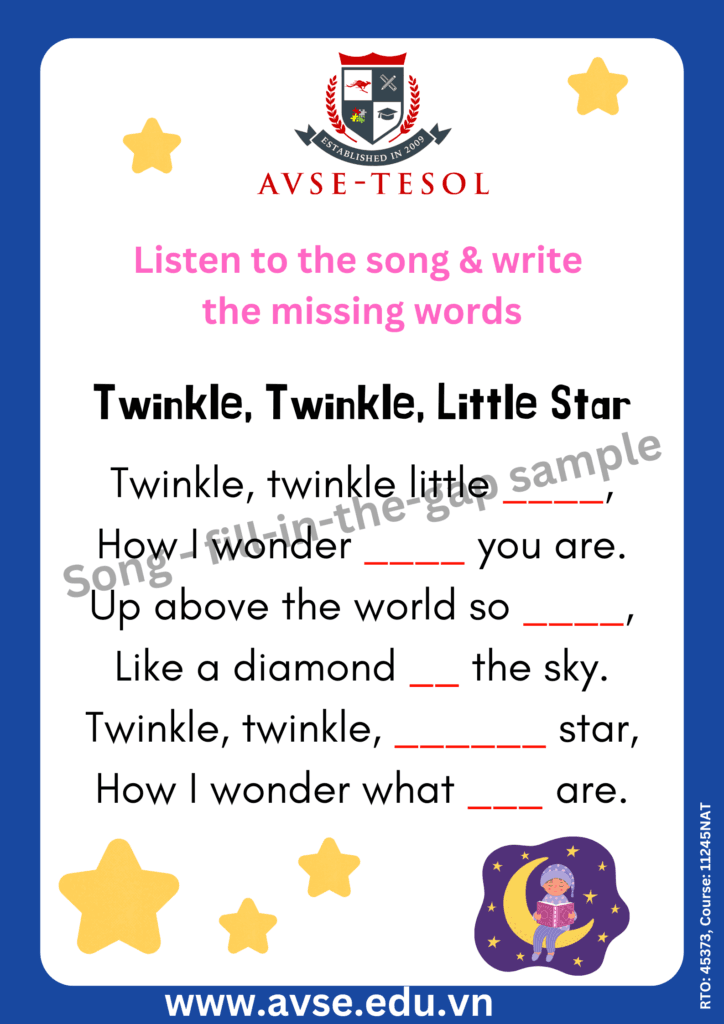
Rhyme activities: Introduce songs with a strong rhyme scheme, for example, ‘Row, Row, Row Your Boat’ or ‘Hickory Dickory Dock’ to help students recognise word patterns. After listening, you can ask the students to identify the rhyming words, reinforcing phonological awareness.
Clap to the rhythm: Choose a song and have students clap to the rhythm. In addition to reinforcing the importance of rhythm, it helps students understand syllables and natural word stress in English. The song B-I-N-G-O’ is a super’ clap to the rhythm’ activity.
Create new verses for familiar songs: Take a well-known song such as ‘If You’re Happy and You Know It’ and encourage students to create new verses based on the vocabulary they’ve been learning, fostering creativity and helping the students practice sentence structure in a fun, musical way. Over the years, I have used this activity with ESL students, from young learners to adults, and it has always been well-received.
Musical storytelling: Use songs to tell stories and discuss the content with the class. For example, ‘The Itsy-Bitsy Spider’ or ‘The Lion Sleeps Tonight’ can be used to narrate a story and follow up with comprehension questions. Students can draw pictures of the story or act it out, integrating multiple learning modalities.
Sing-alongs for pronunciation practice: Play simple English songs and encourage students to sing along. Singing helps children practice pronunciation and intonation in a fun, stress-free way. For young learners, repetition through song helps them internalise correct pronunciation patterns more naturally than through drilling alone.
Music-based phonics practice: Use songs that emphasise particular phonics patterns, such as vowel sounds or consonant blends. For instance, songs like ‘The Alphabet Song’ or ‘The Phonics Song’ can reinforce the sounds of letters and basic phonics rules.
Interactive music and movement: Combining music with physical activity helps children stay engaged while associating language with actions – a super way to teach vocabulary related to movement (jump, clap, spin, hop, and more) – and practice imperatives in a fun way. Think ‘Simon Says’ or the ‘Freeze Dance’ song.
Song-based listening comprehension: Use songs to practice listening skills by asking students to listen carefully for keywords or phrases. For instance, you can play a song and ask students to raise their hands when they hear specific vocabulary words. Alternatively, students can listen carefully and then answer simple comprehension questions about the lyrics.
Tap syllables or natural rhythm: Use a musical instrument or tap a pencil on a desk to teach word stress and sentence intonation. Using music and sounds to highlight a word’s syllables or a sentence’s natural rhythm can give students a clearer sense of how stress and intonation function in English.
Karaoke for language practice: Karaoke is a fun and interactive way to help children practice language. Choose simple, age-appropriate songs and allow students to sing along with the lyrics on the screen. This activity will improve their reading speed and pronunciation as they follow the words and sing along.
Create a class song: Encourage students to collaborate on creating a class song using vocabulary or themes they’ve been studying. This learning activity might involve rewriting the lyrics to a familiar tune or composing something entirely original. An activity of this kind engages students to be creative with language and gives them a sense of ownership over their learning.
Drama & theatrics for kids
How about incorporating drama and theatrics into the teaching and learning experience? You and your students don’t have to be card-carrying thespians. It’s enough to have a spirit of adventure and determination to deliver a teaching and learning experience that’s inclusive, fun and engaging. Drama is a powerful tool for teaching English to children; they get to use the language creatively – and in context. Even simple role-playing activities, for example, acting out everyday situations, can help students practice new vocabulary and sentence structures in a fun, interactive setting. Your students will be embodying different characters and experiencing ‘make-believe’ scenarios. They’ll enhance their speaking skills in an engaging and fun environment. What’s not to love? Bring it on!
Consider:
Role-playing simple scenarios: Kids can act out everyday scenarios, such as going to the zoo, the farm, the doctor or a rocket launch to the moon. Learning activities like those will do wonders for their confidence.
Puppet shows: Puppets have ‘arts & crafts’ and drama dimensions. I have never met a young ESL student who wasn’t excited about including puppets in the learning experience. Students can create puppets using socks, paper bags, or even simple finger puppets – cheap, creative and fun. They can then use their puppets to act out a story or dialogue from a book they’ve read in class – the opportunities to incorporate puppets into the teaching and learning experience are limited only by the teacher’s imagination. Using puppets is a great way for students to practice language skills, particularly those students who are a bit shy.
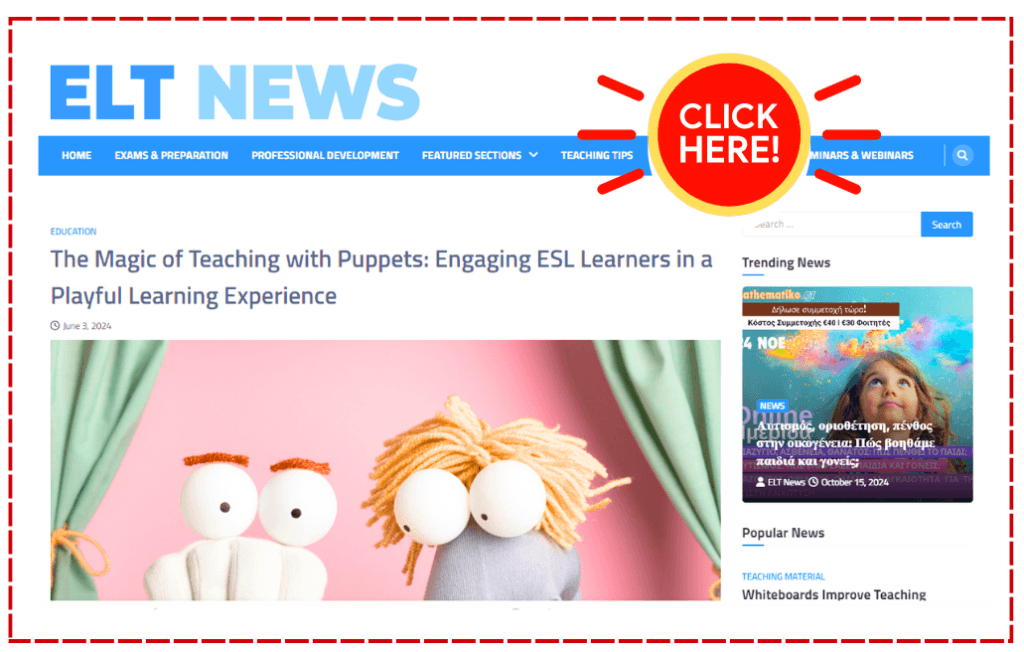
Story dramatisation: Some kids really connect with this activity. You choose a simple story or fairy tale and give each student a role. You read the related dialogue aloud, and your students act out the characters and events. This activity helps with comprehension, listening skills, and understanding of story structure; it also promotes teamwork and creativity. You might be surprised to see how much young learners enjoy acting out stories.
Mime games: Encourage your students to express themselves by miming rather than using words. Simple activities like pretending to be an animal, performing daily actions (like brushing teeth or opening a door), or mimicking weather conditions (wind, rain, sun) help develop physical expression and creativity. Activities like those also promote understanding of body language and non-verbal communication. Who knows? You might discover the next ‘Marcel Marceau’.
Freeze frame: In this learning activity, students act out a scene, but at the teacher’s command, they must freeze in place. The teacher or other students can then describe what is happening in the frozen scene. Freeze Frame is a great way to practice listening, vocabulary, and sentence structure – and build on students’ imagination and quick thinking. It takes a bit of getting used to, but it is a terrific learning activity that’s always well-received.
Emotion acting: Teach students about different emotions by asking them to act out feelings like happy, sad, surprised, angry and suchlike. You can also give students specific scenarios, for example: ‘You forgot to bring lunch to school’ or ‘Your grandmother just gave you some lucky money’ (during the TET holiday in Vietnam). Among other benefits, this activity illuminates the connection between emotions and language.
Dress-up and character-play: Provide costumes, props, or both related to a theme, for example, animals, jobs, cooking, in the classroom, and ask students to create short scenes or skits. Dress-up and character-play activities help students develop language skills playfully and imaginatively while promoting teamwork and creativity.
Action songs and rhymes: Use songs or rhymes that involve actions and have students act out the motions. For example, songs like ‘If You’re Happy and You Know It’ or ‘Head, Shoulders, Knees, and Toes’ combine language learning with physical activity, helping reinforce vocabulary and language comprehension through movement.
Competitive games
Vietnamese and Cambodian folks of all ages love sports and games, especially the competitive element. Regardless of the sport, in cities and towns the length and breadth of Vietnam and Cambodia, you’ll see whole families glued to the television when a national team is engaged in a competition. Moreover, you’ll see children spending a lot of time playing street games like ‘kick the shoe’. You can use this seemingly innate love of sports and games to your advantage when teaching English to kids in Southeast Asia. Physical activities offer an energetic way to teach language concepts. Games like Simon Says and Scavenger Hunt can be modified to focus on vocabulary or sentence structures. Videos of soccer, football, and basketball games offer engaging opportunities to teach concepts like prepositions of place and adjectives. Classroom games with a competitive bent are always well-received as an icebreaker, especially when the competing teams are gender-based.
Consider:
Race to the whiteboard & relays: In-class ‘race to the whiteboard’ and relay races in one form or another are staple activities in ESL classrooms across Southeast Asia. Suppose your class has ten students. Divide the students into two groups of five students. Each group stands in a line, about, let’s say, five metres from the whiteboard. The teacher displays an image via PowerPoint, and one student from each group runs to the whiteboard and writes the corresponding vocabulary word. Whoever finishes the quickest earns a point for their team. Once a student has had a turn, they go to the end of the line so all students participate equally. The team with the highest points after a set period wins the activity.
Action bingo: Create a bingo card filled with action words like ‘jump,’ ‘jog on the spot,’ ‘clap, ‘spin,’ and ‘hop’. Instead of calling out numbers, the teacher calls out actions. Students with the action on their bingo card mark it off as they would in a traditional bingo game and do the action. The first student to complete a straight line on their card wins.
& more: Here is a random collection of other competitive games that I’ve seen work well in ESL classrooms in Vietnam and Cambodia: Animal Charades, Red Light / Green Light, Parachute Games, Hopscotch with Numbers and Letters, Find the Flashcard, ‘Duck, Duck, Goose’ (with a Twist), Balloon Pop Quiz, Running Dictation, Tunnel ball and the list goes on.
Media
There is a stand-alone module in this TESOL course focused on the importance of computer-assisted language learning (media) across the board in ESL teaching and learning, including when presenting information to students. Please refer to this Module for guidance on how teachers can use media and technology to make their ESL lessons engaging and fun for learners of all ages and skill levels.
Presenting Online:
Teaching ESL online presents distinct challenges for educators that differ from traditional in-person instruction. Some teachers thrive in an online teaching environment where the instruction is primarily one-on-one; it can take place in the comfort of their living room – and comes with a level of freedom that most in-class teachers can only dream about. Online ESL teaching has upsides, but the virtual setting can be challenging, especially when presenting new material. Let’s take a quick look at four common challenges and possible responses.
Challenge 1 – Engagement and interaction: The lack of a physical classroom, coupled with only one student present most of the time, gives rise to an obvious challenge – a lack of atmosphere. The positive impact of ‘vibe’ on teaching and learning outcomes in ESL, where the content tends to be mundane, cannot be overstated. Presenting vocabulary, grammar points and the like in a virtual environment to a single student is arduous, even if the teacher is the consummate professional and the student is highly motivated. In stark contrast, in a formal classroom environment, students feed off the teacher’s energy – and energy from their classmates, creating a positive vibe that enhances teaching and learning.
Response:
– Use a mix of interactive tools in each lesson to capture and hold attention – videos, flipbooks, infographic PDFs, polls, quizzes and the like.
– Negotiate learning goals with the student from the outset and regularly check progress. Open dialogue is imperative.
– Ensure every lesson is well-planned, follows a clear structure and includes short, sharp learning activities to achieve desired outcomes. Change the lesson structure occasionally to avoid monotony.
– Encourage active participation in each lesson by including role plays, storytelling, competitive games with a learning goal dimension, questions and answers – and plenty of positive feedback.
Challenge 2 – Distractions: Both online and in-class study programmes experience distractions of one kind or another. Online, it might be as simple as the teacher’s cat walking across the keyboard. In a regular school environment, the distraction might be a student meandering into the wrong classroom or a knock on the classroom door by someone from the school office seeking to resolve an administrative matter. From my observations over the years, distractions during an online ESL class are more frequent – and harder to recover from than in-class distractions. Why? Read on.
Students who attend an online class are often in their kitchen, living room, or bedroom, surrounded by distractions, such as the doorbell, gadgets on the desk, pets, family members, cooking dinner, and the like. Teachers taking online classes from home, a coffee shop or elsewhere are surrounded by the same distractions.
Another reason distractions seem more frequent and impactful with online classes is the difference in accountability between the two learning environments. Online, students are primarily accountable to themselves. In a traditional classroom, however, the physical presence of classmates and the teacher reinforces the importance of staying focused and naturally discourages off-task behaviour.
Response:
– As much as humanly possible, the teacher and the student should take steps to reduce the likelihood of distractions of one kind or another disrupting the online class – close doors, no eating, secure pets, silence the doorbell and so on. Reducing the likelihood of distractions can be as simple as both parties committing not to be distracted for the duration of the lesson other than by a ‘force majeure’ event.
Challenge 3 – Technical issues: Technology and technical issues go ‘hand in glove’. Unstable internet access, electricity outage, a flat laptop battery, malware, webcam malfunction and audio problems are just a random selection of a multitude of technical issues that can bring even the best-planned online ESL class to an immediate close.
Response:
– Both the teacher and the student should proactively maintain their computer hardware and software to ensure everything is running smoothly. Regular spot checks help identify potential issues early, allowing them to be fixed before they become major problems.
– Online ESL teachers (and students) would be well-advised to work on their technical skills to fix ‘everyday’ IT problems without relying on a third party, who may not be immediately available.

Challenge 4 – Correcting, Assessing and Feedback: Correcting, assessing, and providing feedback are all core responsibilities of a professional ESL teacher. In a typical classroom environment, teachers can observe a student’s body language and other non-verbal cues to sense confusion, frustration, or disagreement – especially when correcting, assessing or providing feedback. Observing body language and the like is far more challenging online, where the teacher can easily miss subtle cues. Missing important cues that give insight into how a student feels at a point in time can negatively impact teaching and learning outcomes.
Response:
– If you plan to teach English online, developing super-duper skills in interpreting body language and other non-verbal cues can profoundly enhance the teaching and learning experience. It will help you identify potential issues at the earliest opportunity and apply strategies to address them before they become major challenges.
– In an online learning environment, building robust and two-way rapport (teacher + student) where open dialogue is encouraged and practiced is paramount. When rapport and open dialogue are in place, correcting, assessing and providing feedback become much easier and more effective.
Characteristics of a brilliant ESL presentation:
Capturing attention, holding interest and being comprehensible are admirable goals when presenting material in an ESL class, but what can you do to maximise the likelihood that your presentation will tick all the boxes? We should reflect on our customer’s views – ESL students and, in many cases, their parents. With this idea in mind, in late 2023, the Australia-Vietnam School of English (AVSE) in Ho Chi Minh City, Vietnam, surveyed 327 fee-paying students (and parents) to gain insight into the characteristics of a brilliant ESL presentation from a customer perspective. The survey was not scientific; nevertheless, 12 points stood out. The survey found that teachers should:
- Know the subject matter and be well-prepared
- Avoid talking too much
- Ensure material is relevant – age, skill level, subject matter
- Use a mix of exciting teaching resources – be quirky
- Give verbal instructions that are short, simple and at an appropriate pace
- Incorporate a mix of short, sharp learning activities
- Involve all students – face students when talking
- Roam constantly – take an interest in students – don’t sit at the teacher’s desk
- Be lively, perhaps even dramatic (‘edutainment’)
- Constantly check for understanding – give a lot of positive feedback
- Maximise the use of information technology
- Use of nonverbal cues
- Think about voice projection and tone
- Get to know students
Do you agree with all 14 points noted above, some of them or none of them? Did any of the points from the ‘survey’ surprise you? What other points, if any, would you add to the list?

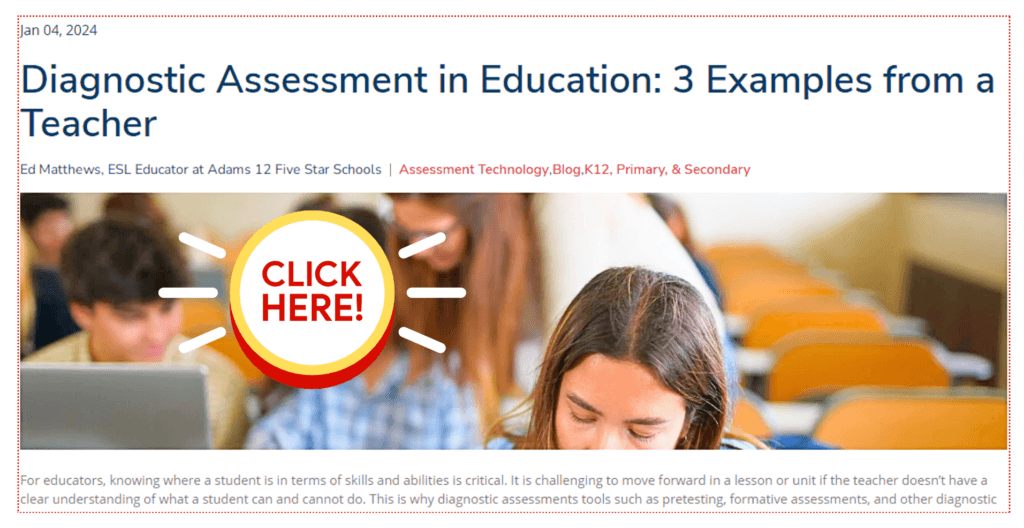
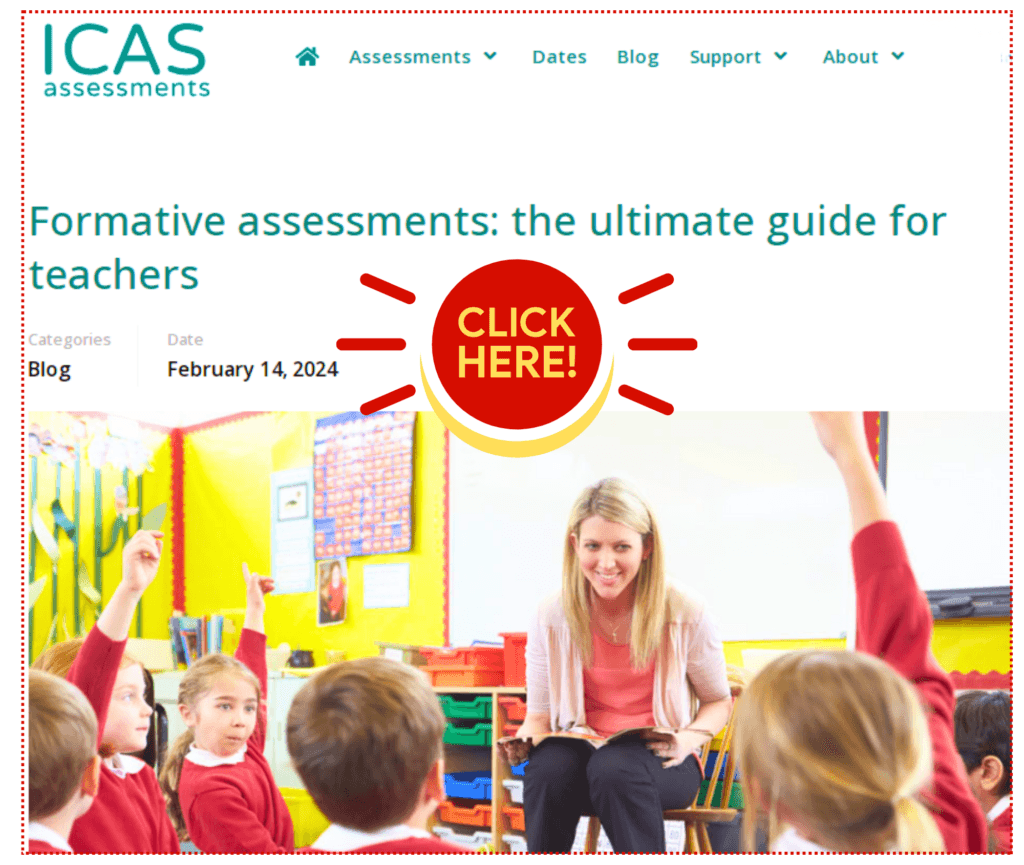
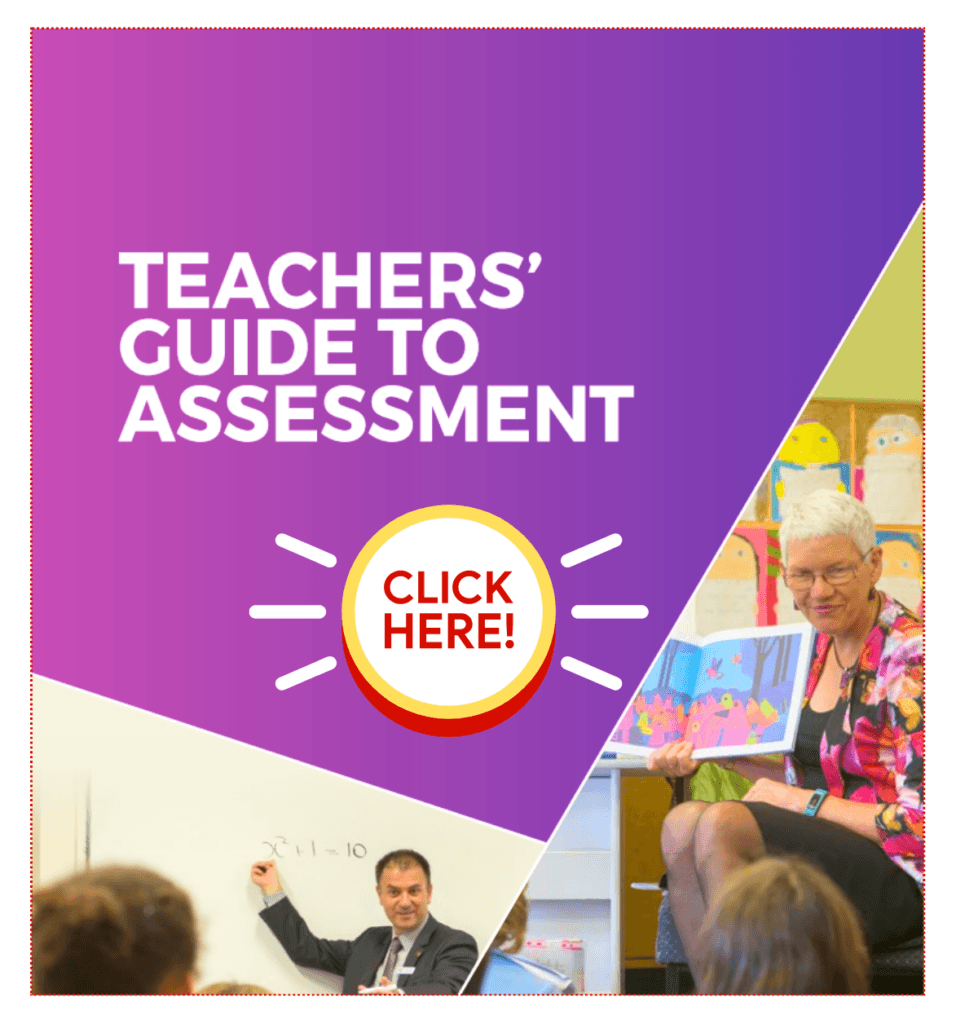
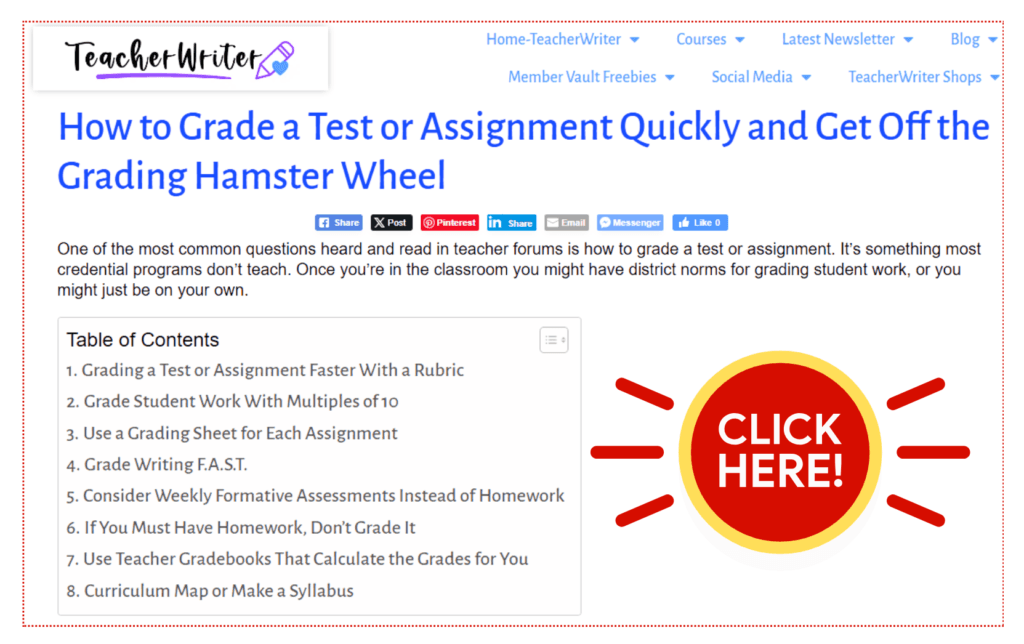

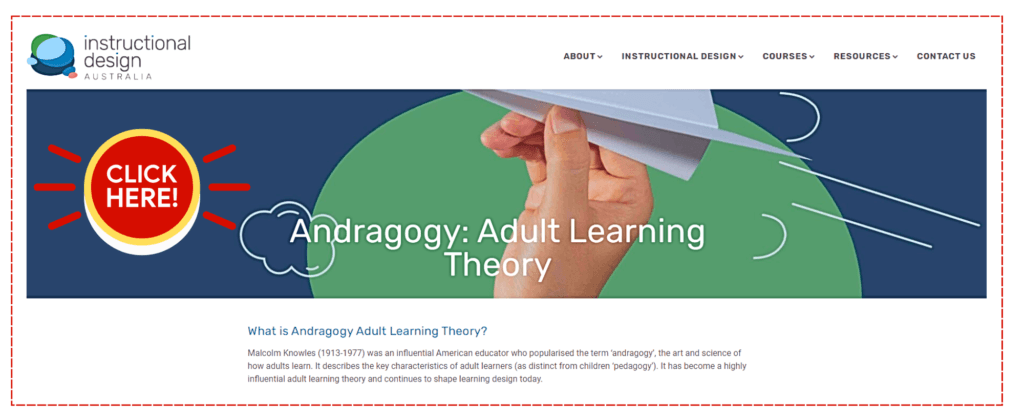
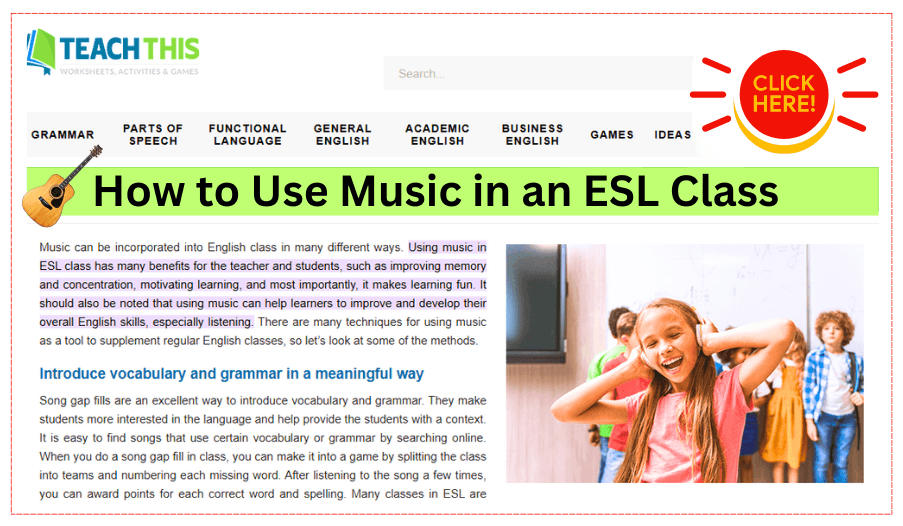


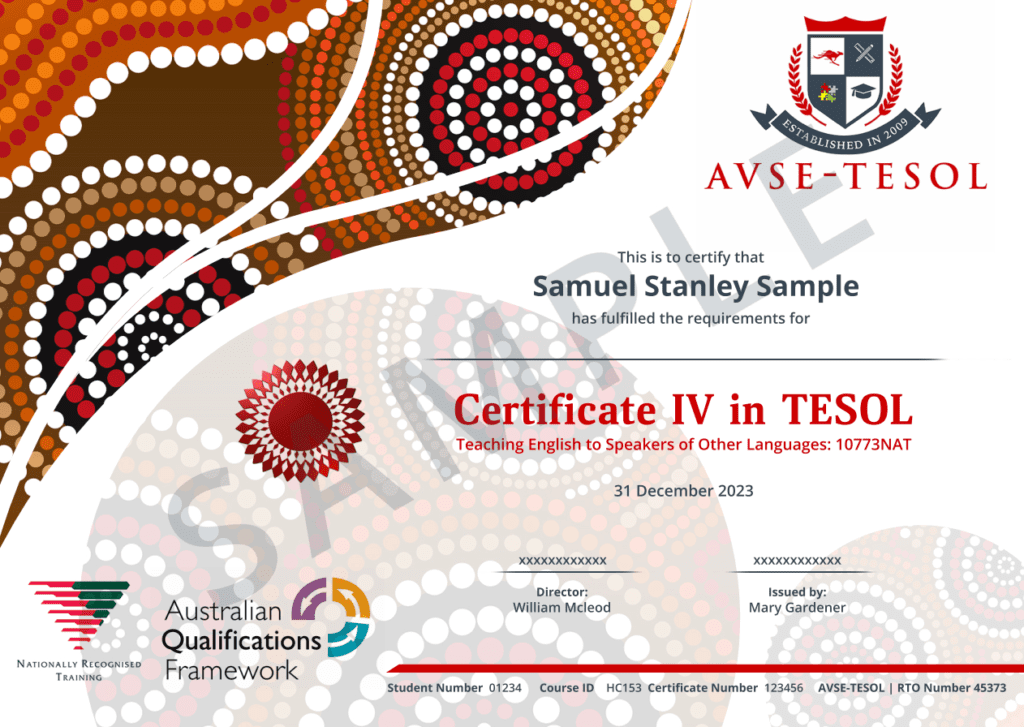



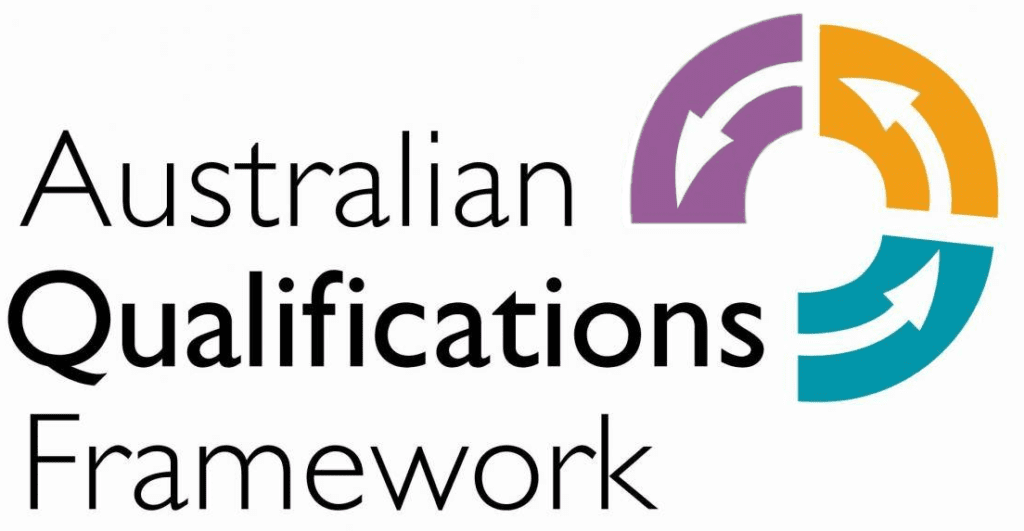







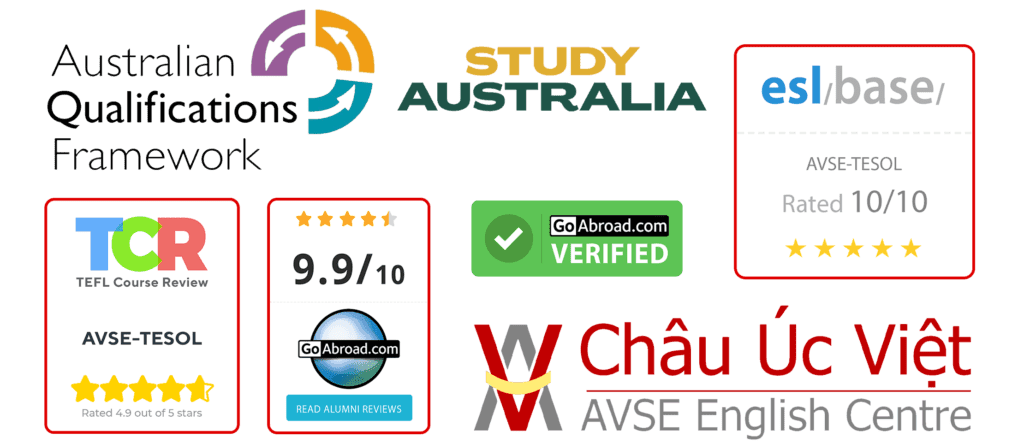
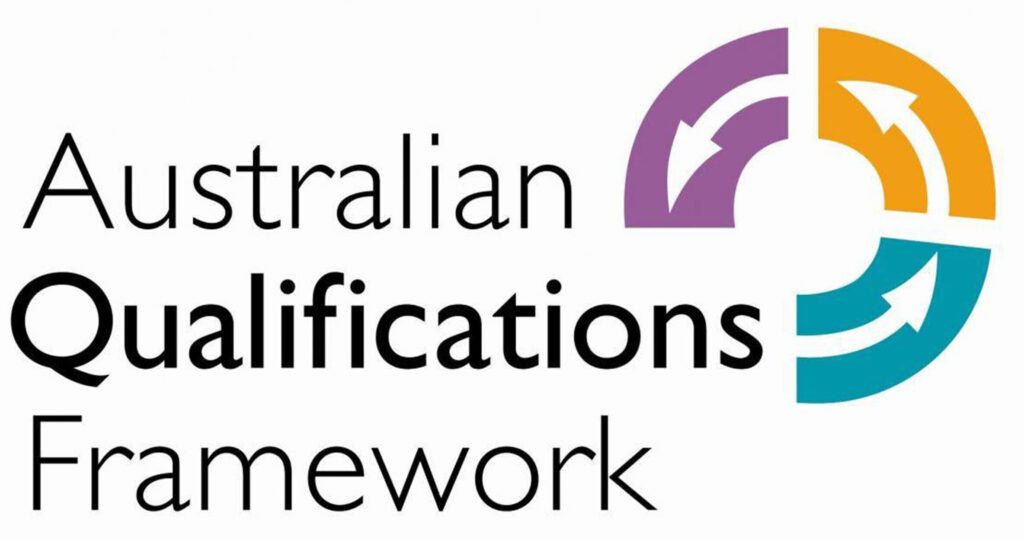





















Recent Comments